Pekka Buttler, February 2021 – June 2022
Welcome to part 5 of the JAPB comparison of nine fast fifties. This is a big article, that has been subdivided into several parts for convenience and the sake of humane loading times.
This is Batch I of JAPB’s comparison of fast fifties. Have a look also at the ‘cover page’ of the entire fifties -comparisons here.
Table of contents
• Part 1: Introduction, the lenses: pedigree and handling
• Part 2: IQ-comparison I – The Brick wall test
• Part 3: IQ comparison II – Urban vistas
• Part 4: IQ-comparison III – Bokeh and blur
• Part 5: IQ-comparison IV – Night-time vistas (you are here)
• Shooting in the dark
• Night-time urban vistas
• Bokeh balls
• Stargazing
• Part 6: Summary and conclusions
Shooting in the dark…
Large aperture lenses are typically heavier and significantly more expensive than a smaller-aperture variant of the same lens. For instance, the Canon FD 50/1.4 ‘chrome nose’ (weight 370 g) cost 22 000 yen when introduced in 1971, while its less bright sibling, the Canon FD 50/1.8 (weight, 305 grams, not part of the comparison) cost only 14 800 yen when introduced the same year. On the other hand, the even brighter Canon FD 55/1.2 (weight 565 grams, also not part of this comparison) cost 39 000 yen (also introduced 1971) (price and weight info from Canon Camera museum).
Therefore, to acquire a wider aperture lens (when smaller aperture alternatives are available), one typically needs a motive: These motives mainly fall into three categories:
1# Hoping for the shallower depth of field offered by a wider aperture;
2# Being able to shoot in less light
3# Added kudos (among photographers) of carrying a high-end lens.
Finally, there is also a widespread belief that wider-aperture lenses produce better images at medium apertures (say f/2.8–f/8), which I will mention, but which I do not fully subscribe to (I’ll write an article on this one day). But considering that we typically today shoot these lenses at sensitivities beyond the dreams of photographers back when these lenses were new, I will say that the main weight of these motives today is less on point 2 (low light) and more on point 1 (shallow DOF).
In any case, the ability to shoot in low light (think: Christmas dinner, candle-lit events, etc.), even utter darkness (think: astrophotography) is one prime motive for wanting a fast lens. Hence, no comparison of fast fifties would be complete without some night-time vistas and star-shots, especially as night-time shots and starlit skies can be very revealing test subjects.
Why darkness-shots should be included in every test:
In case you already know why that is, you can jump to the imagery, but in case you do not, allow me to say a few words.
Optical systems (such as lenses) typically are designed to satisfy a prime requirement: to bend light in a specific way, so as to capture an angle of view, and project that angle onto a recording medium (film or sensor). In so doing (during that bending), side effects tend to creep in and these side-effects lead to that the projected picture (onto the film/sensor) is not precisely as one would want. Those side effects are generally referred to as aberrations (and if you want to learn more about them JAPB offers an entire series of articles on various optical flaws and aberrations).
Some of these aberrations (such as geometric distortions, spherical aberration, and lateral chromatic aberration) are readily observable in almost any shot, whereas with some others (specifically astigmatism, comatic aberration, and (to a lesser degree) field curvature) it is often hard to discern exactly why the image is not exactly as it should be. The main problem with these aberrations is that – looking at any of the earlier test shots – you can for instance see that the corners are not sharp, but you cannot know why because with all the stuff you have going on in any normal picture, the aberrations tend to bleed together.
But with night time vistas you can. Night time vistas are characterised by that an absolute majority of the image is basically black, interspersed with distinct point light sources here and there. And when you have such light sources in e.g. a frame corner, they will most certainly indicate very precisely whether one is dealing with comatic aberration, astigmatism, field curvature or (as is often the case) a combination of two or more aberrations.
And even when you could not care less about astrophotography or how your lens would handle that situation, you can be sure that whatever aberrations affect that lens’ ability to render a star-field precisely, those same aberrations will affect your lens’ ability to capture a landscape precisely.
Yes, obviously, I’m resorting to some hyperbole (because if you really want a sharp landscape, you won’t shoot anywhere near wide open), but the point is that night-time and astrophotography tests have a wide-ranging real-world relevance.
Night-time urban vistas
Welcome to Helsinki, Finland, the world’s second most northerly capital (second only to Reykjavik) and the only city with in excess of 1 million urban population with a latitude over 60 (north or south).
Situated at roughly 60° N, ‘Night-time’ is very seasonal: In winter nights are very dark (especially away from light-pollution), while in summer, darkness can only be achieved indoors. The image below serves both as a legend of where the excerpts are from and illustrates what “night-time” also can mean. The image is taken over Töölö inlet towards the main rail line, at 01:00 AM on the 14th of June. With still a week to midsummer solstice, this is as dark as it gets. The exposure, at 6EV, corresponds to “Bright indoor lighting” according to most EV charts (one such example here).
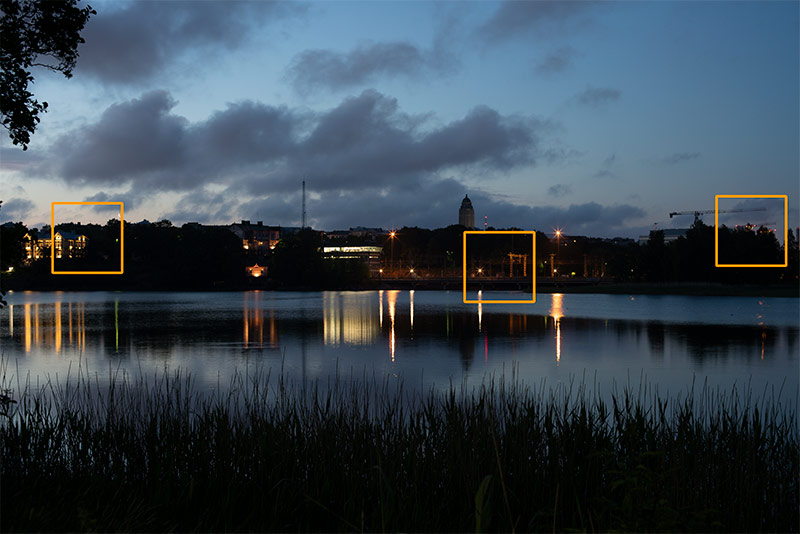
In case you might have never experienced polar regions, you might be thinking: “no way can it be that light at 1 AM – he must’ve tweaked the exposure”, you’re right and you’re wrong. Hoping to not blow the highlights, the images were taken at -3 EV, whereafter I raised exposure in post by 2 EV – a trick I often do when shooting at night, because I feel it gives me both a very ‘realistic’ feel of how dark it really was, combined with good behaviour on the camera’s part.
Specs for the shoot: 14.6.2022 between 0:50 and 1:05. Tripod, cable release, Sony ⍺7R2, WB Daylight, ISO100, SteadyShot Off, effective EV correction -1.
Excerpts below:
• Left: Illuminated facade of ornamental villa (behind focus point, 550 m distant)
• Centre: Point-light-source and Railroad overhead cable gantry (focus point, 500 m distant)
• Right: Warning lights at top of high-rises (far behind focus point, 3 000 m distant); crane gantries (behind focus point at about 825 m distant)
@ f/1.4
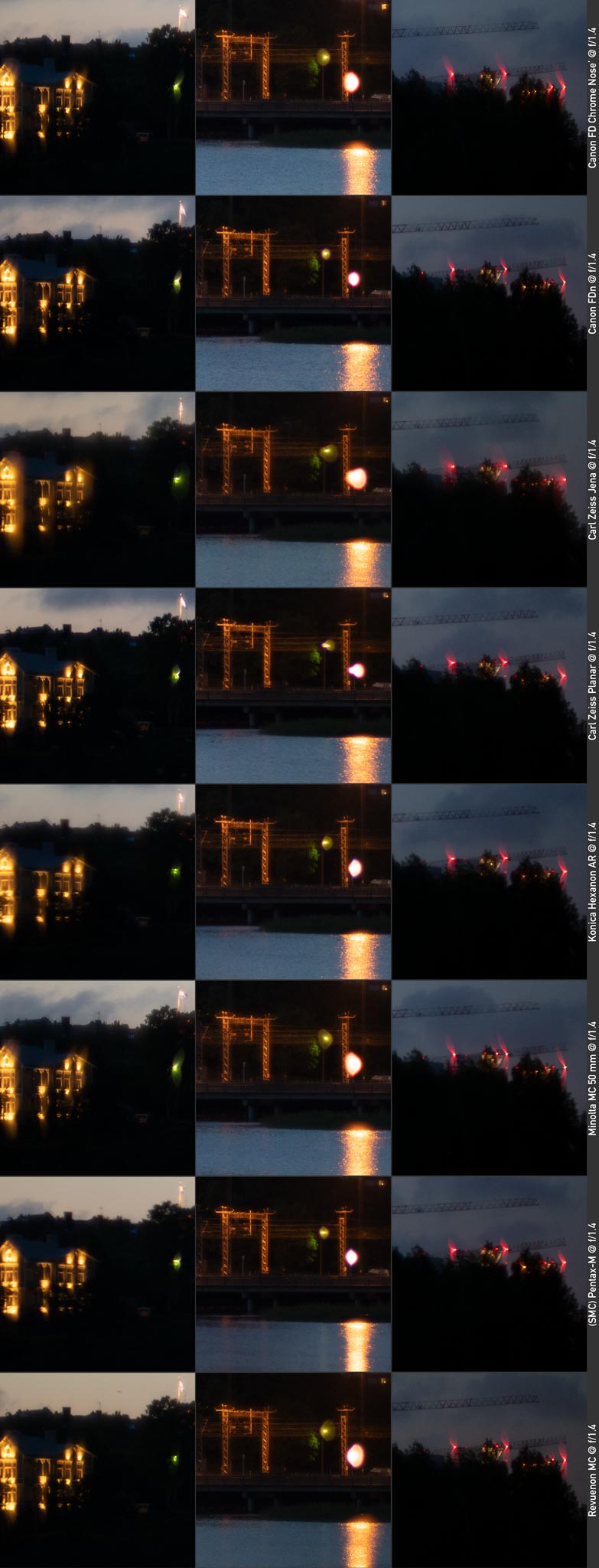
Quick analysis:
• All lenses show heavy astigmatism in off-centre areas and significant highlight-veiling (flare) in the centre.
• These aberrations are of such a caliber, that they would show up even in a 15×10 cm print.
• Even so, some lenses are better than others: Canon FDn and Pentax show less centre veiling; Canon FDn, Zeiss and Revuenon resolve more detail in the lit facade. In low-contrast situations (e.g. Crane in right-hand sample) Canon ‘chrome nose’ puts in a good performance.
• Carl Zeiss Jena shows the least clean image (more veiling, more astigmatism)
@ f/2
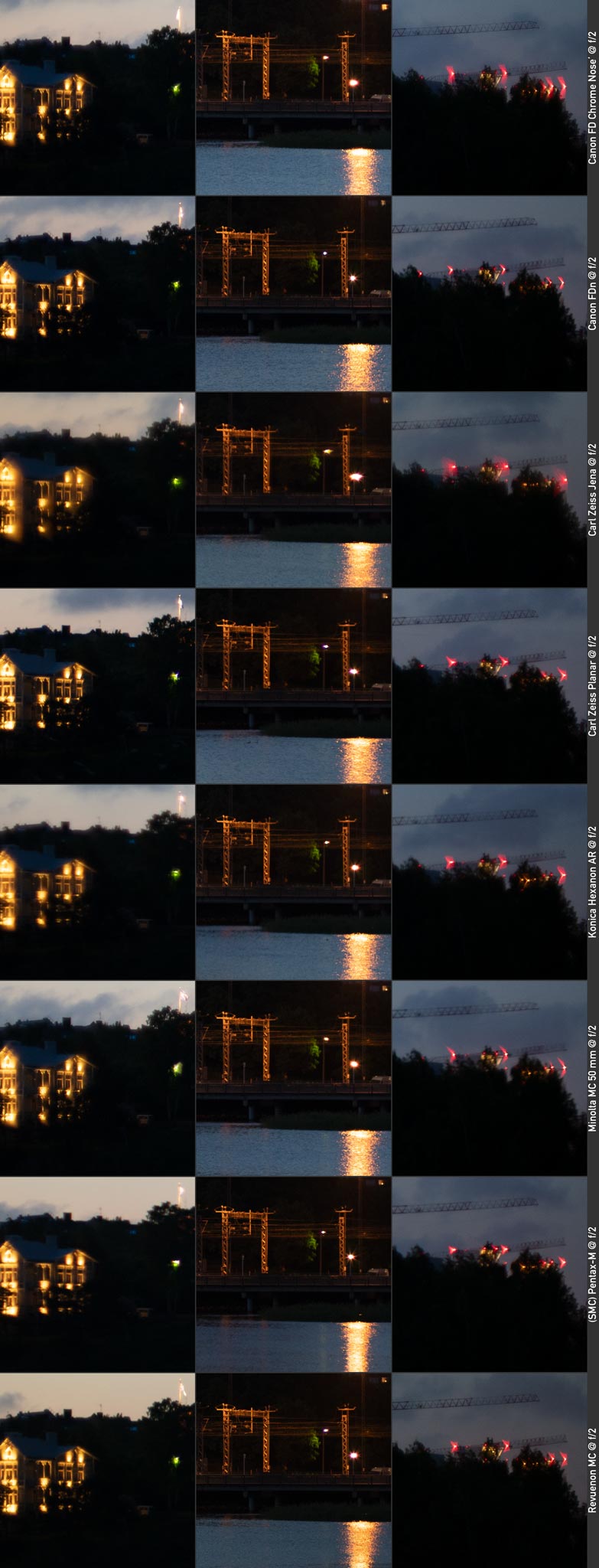
Quick analysis:
• The centre-areas show vast improvements, but all lenses still evidence some veiling. Some less (Canon FDn, Carl Zeiss, Pentax), others more.
• All lenses still show significant astigmatism-artefacts in the off-centre area.
• Unless enlargements are needed, f/2 will in a pinch be entirely satisfactory.
@ f/2.8
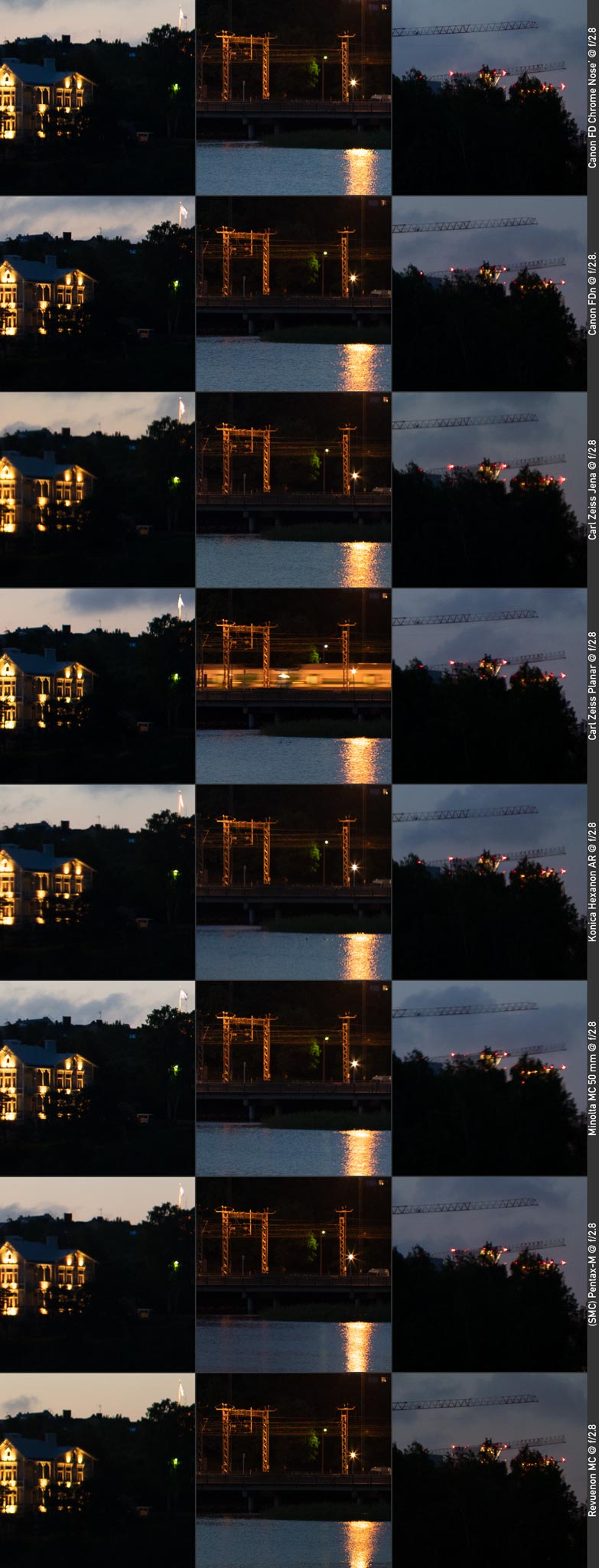
Quick analysis:
• f/2.8 shows another significant improvement:
• centre-region veiling flare is almost entirely gone (the pixel peeper may discern some) and the first, moderate sunstars appear around the brightest light-points.
• Also astigmatism artefacts in the off-centre regions are significantly reduced, but all lenses still show them (the Canon FDn comes closest to eradicating astigmatism)
• Notwithstanding the Carl Zeiss Jena, all lenses manage to produce (for f/2.8) clean high-contrast detail.
@ f/4
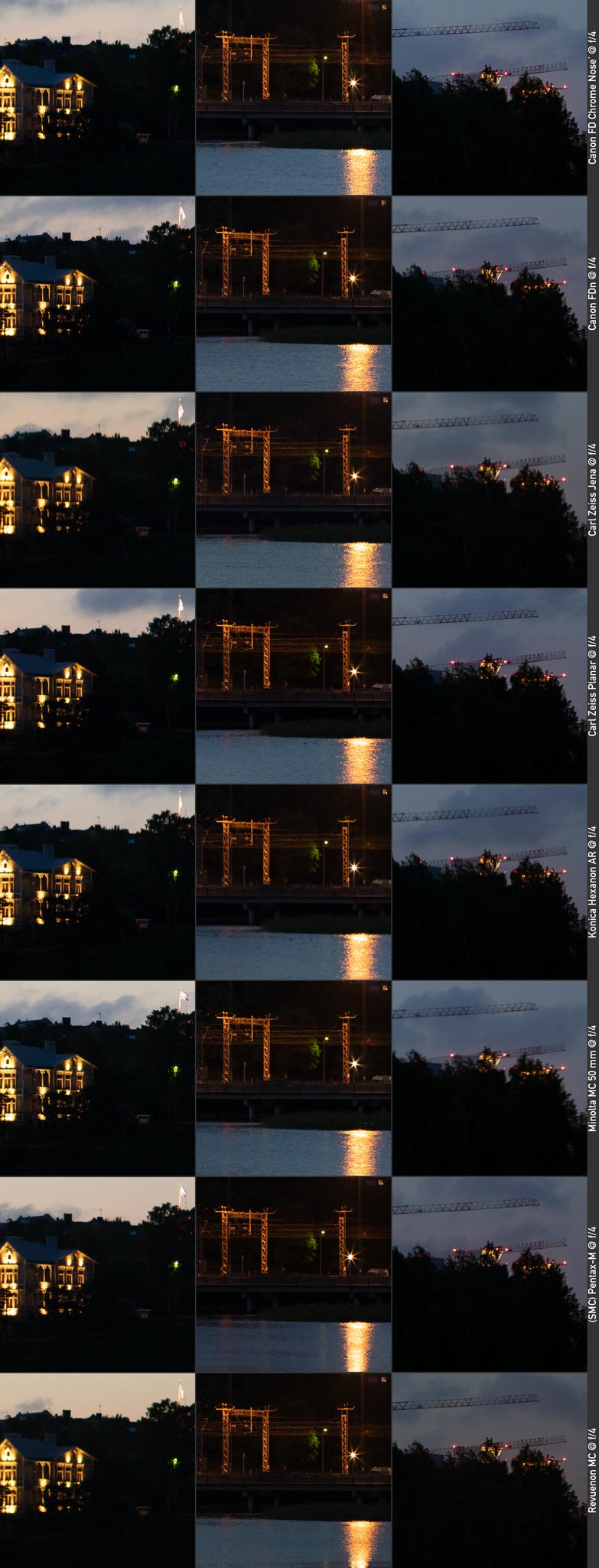
Quick analysis:
• Another, albeit less significant improvement:
• Centre-areas are fundamentally clean and show prominent sunstars.
• Astigmatism artefacts are fundamentally gone, leaving only a remnant of negative comatic aberration, which is (in this scenery) not field-relevant.
• That said, looking at overall detail, the Canon FDn definitely aces this test (a good indicator of detail is the small aerial visible next to the flagpole in the left-hand excerpt).
• Side note: the Minolta 50 mm shows good detail on the left, but not good detail on the right. Given the difference in distance involved, that might either indicate decentering or a field curvature that is significantly stronger than the competition’s.
@ f/5.6
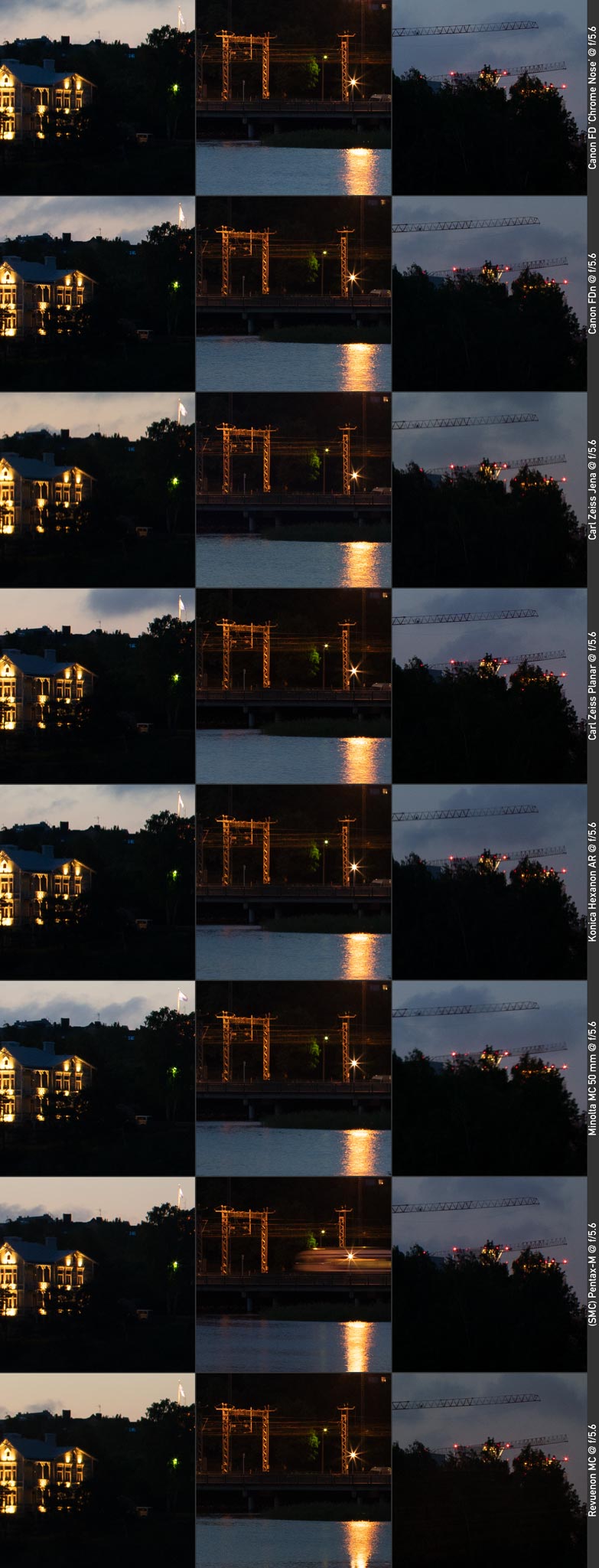
Quick analysis:
• Fundamentally clean images all-around.
• f/5.6 is also the point at which strong light-points start producing some sunstars also in in the border areas.
• If you have a tripod, and your scenery does not move, f/5.6 is pretty much the widest aperture one should use if a clean and aberration-free image is your goal.
@ f/8
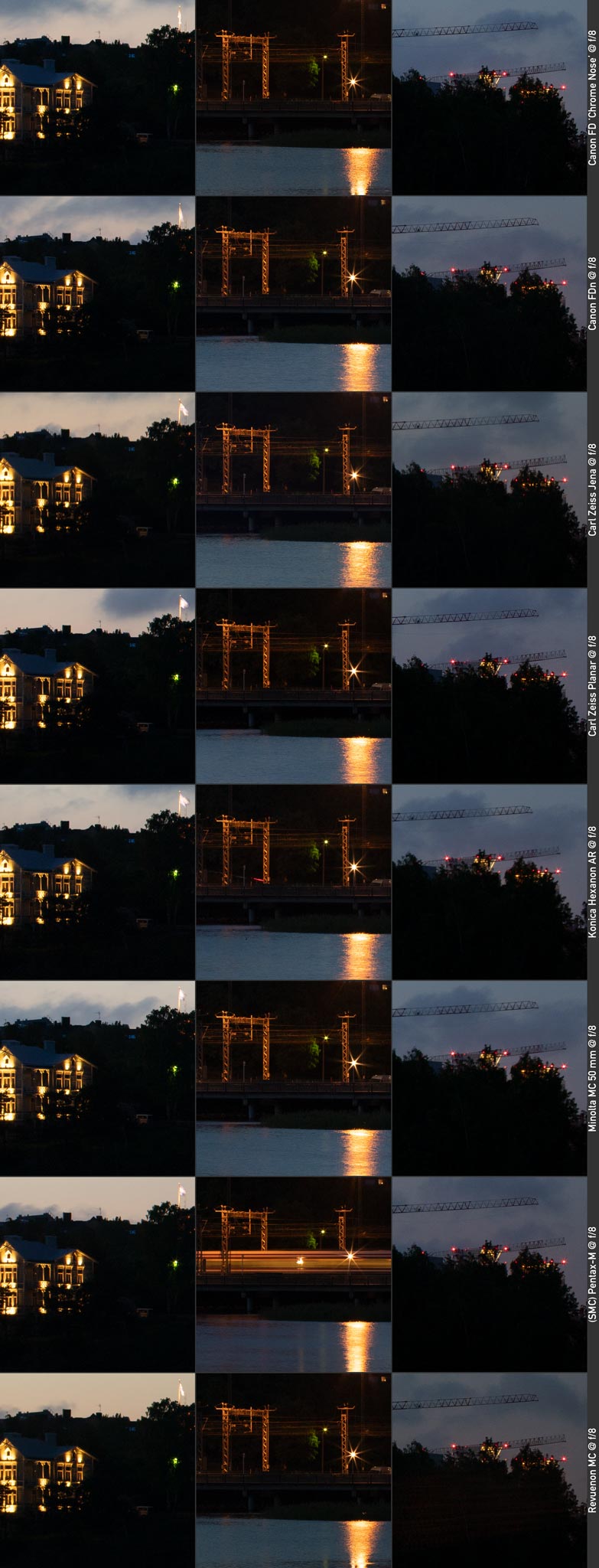
Quick analysis:
• f/8 shows minor improvements across the board.
Bokeh balls
Many photographers – especially during the dark season and when variously coloured Christmas lights abound – love their ‘bokeh balls’. However, investigating bokeh balls does have many uses. To learn more about the topic, look at this article.
The excerpts below (all lenses from wide open to f/5.6) are taken with the lens set to MFD, and the bokeh balls are generated by city lights roughly 1000 meters away. The camera was tilted to line up the horizon corner-to-corner. The excerpts are from the area highlighted below in the orange rectangle.
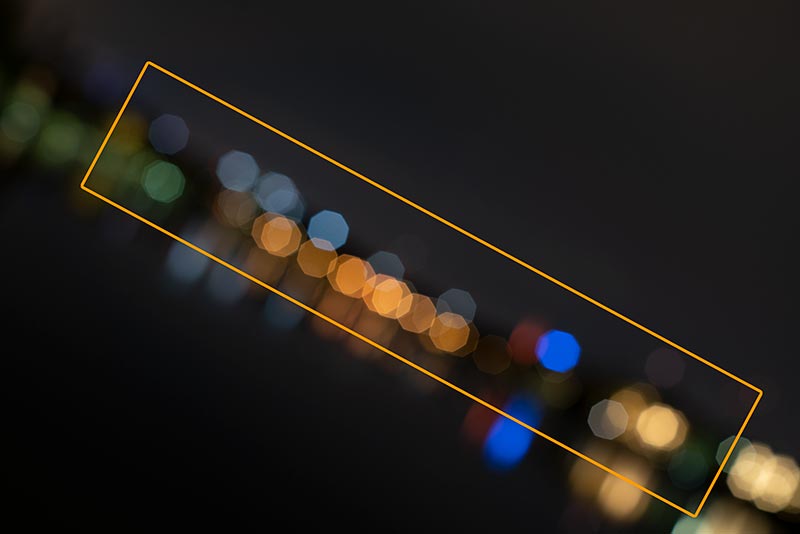
Canon FD 50 mm f/1.4 ‘chrome nose’
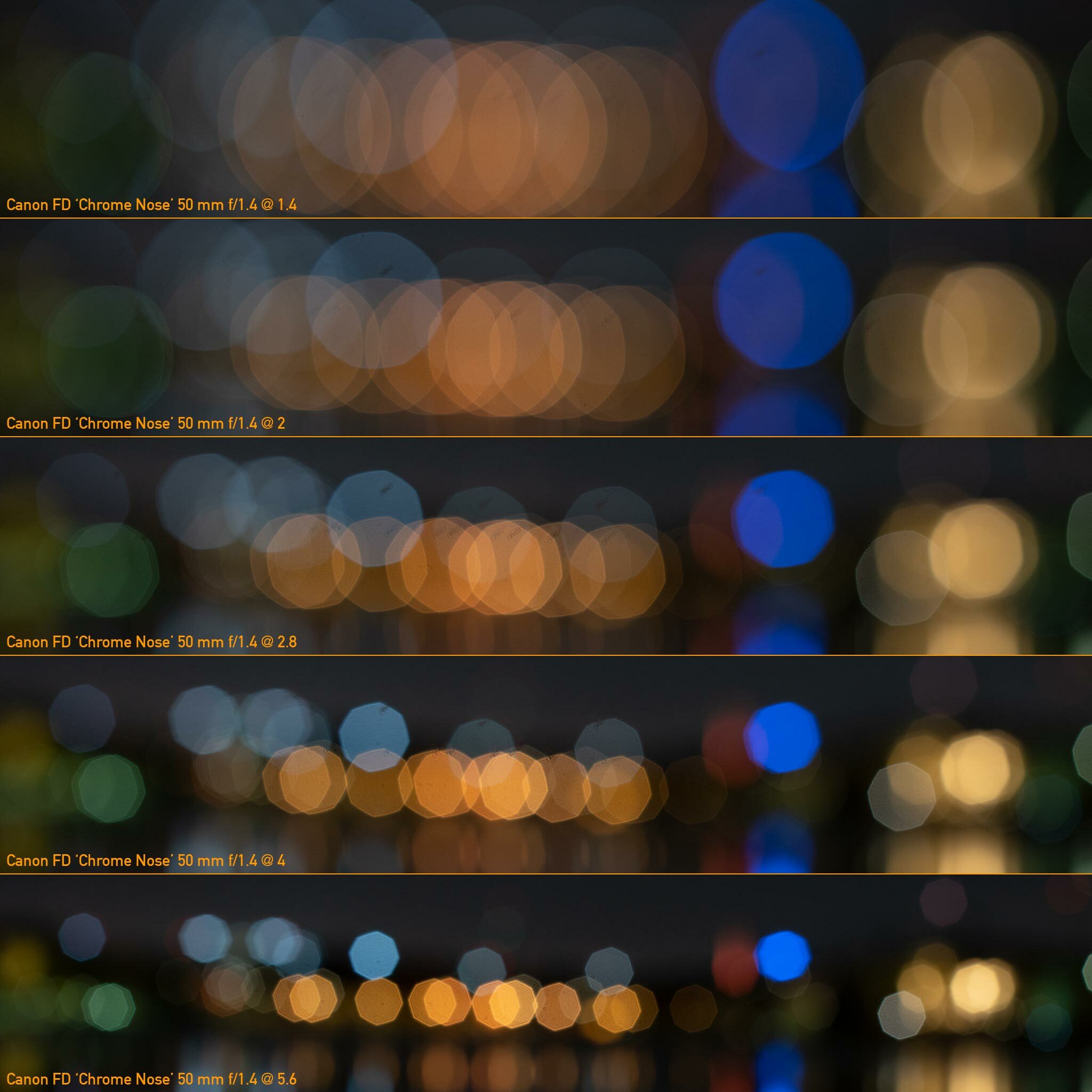
Quick analysis:
f/1.4 Circular, well corrected bokeh balls, but with noticeable optical vignetting except in the absolute centre.
f/2 Well-corrected, very rounded octagon, with optical vignetting only in border areas
f/2.8 Distinct octagon, but with rounded corners. No optical vignetting but some mild outlining
f/4–f/5.6 Distinct octagon with pronounced corners. No optical vignetting but mild-medium outlining
Canon FDn 50 mm f/1.4
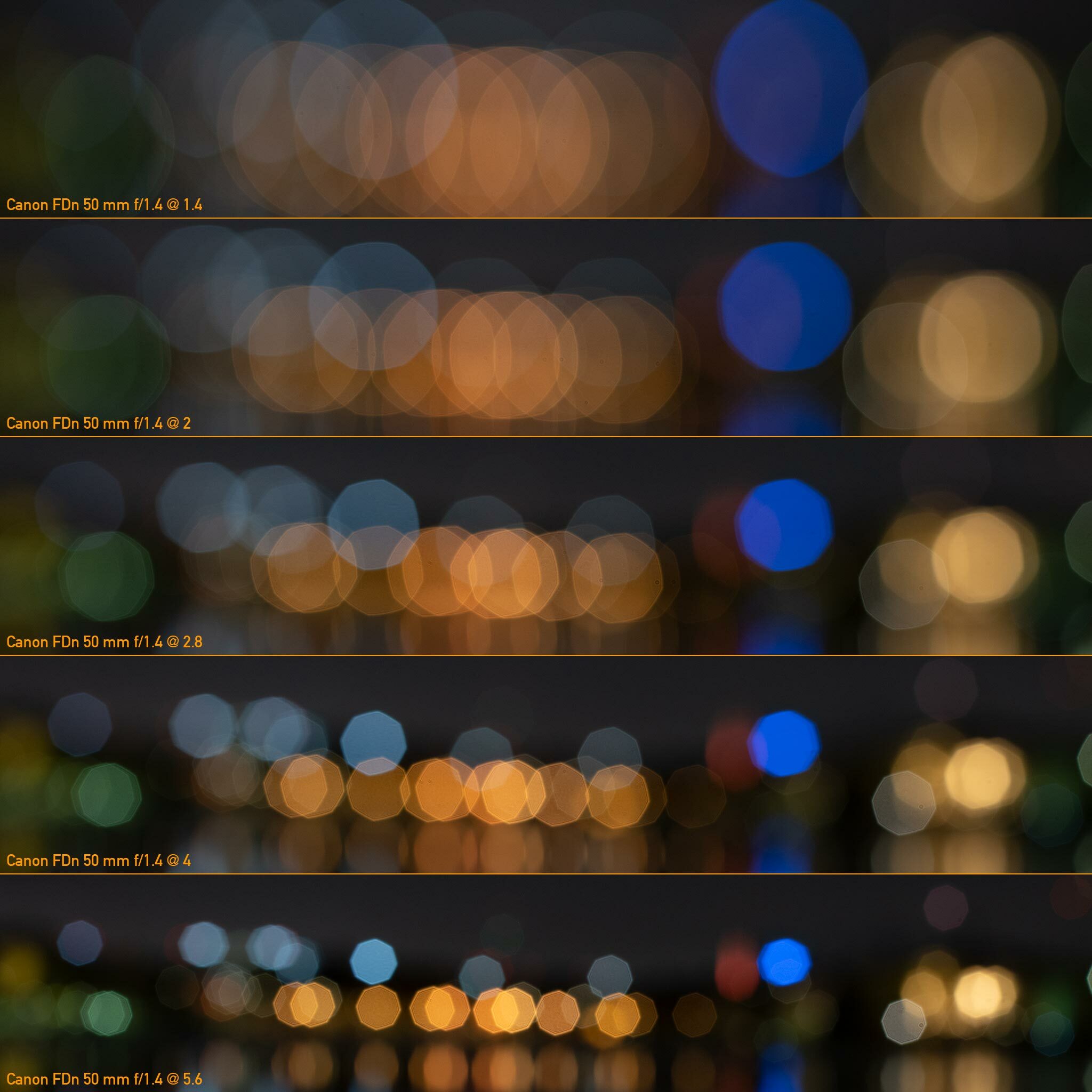
Quick analysis:
f/1.4 Circular, well corrected bokeh balls, but with noticeable optical vignetting except in the absolute centre.
f/2 Corrected with very mild outlining. Very rounded octagon, with optical vignetting only in border areas
f/2.8 Distinct octagon, but with rounded corners. No optical vignetting but mild onion-ring outlining
f/4–f/5.6 Distinct octagon with pronounced corners. No optical vignetting but distinct onion ring outlining.
Carl Zeiss Jena 50 mm f/1.4 Prakticar
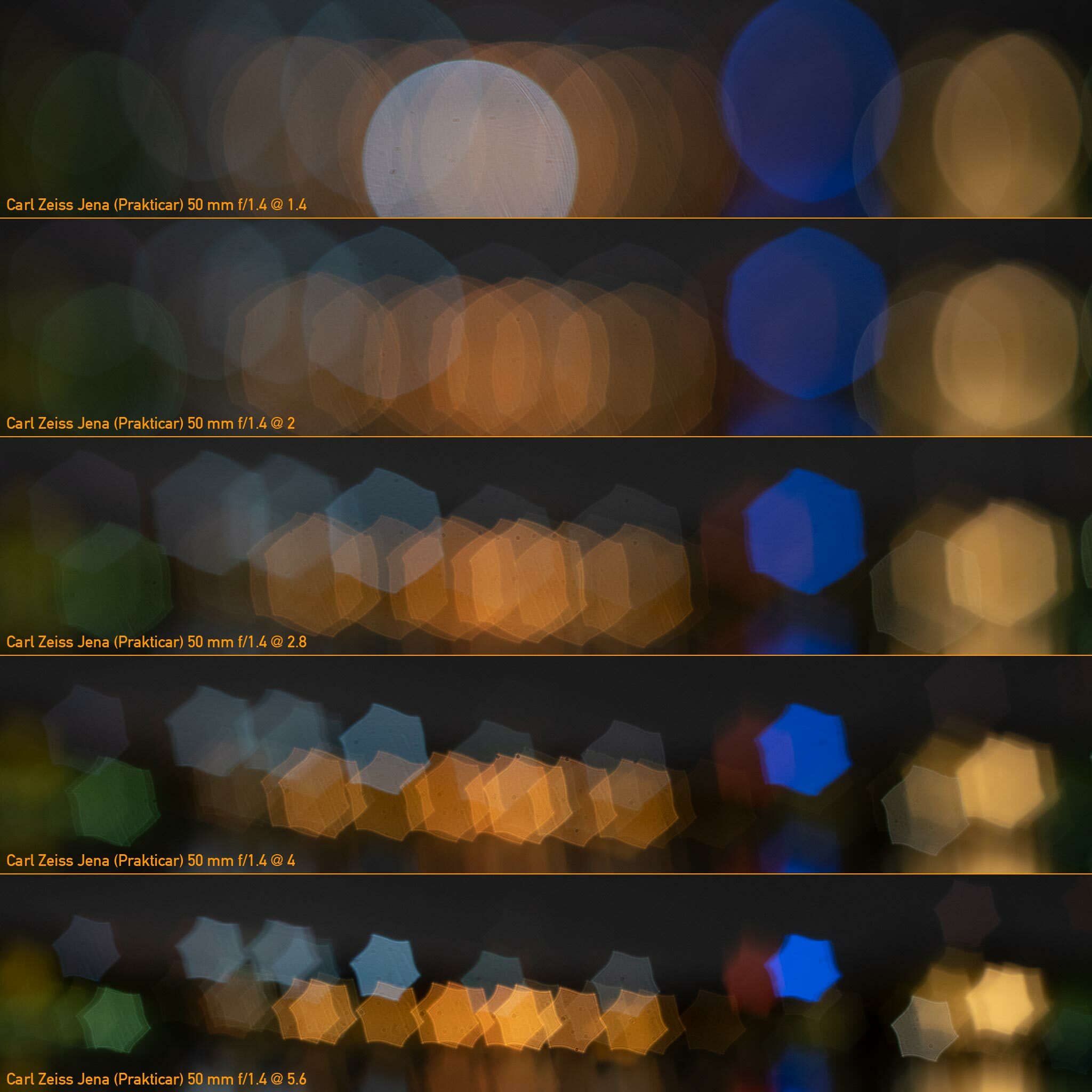
Quick analysis:
f/1.4 Circular, well corrected bokeh balls, but with noticeable optical vignetting in border areas. Striation pattern in specular highlight.
f/2 Corrected with very mild outlining. Not rounded, not hexagonal, more like a saw blade. Optical vignetting only in extreme corner.
f/2.8–f/5.6 This is the real Ninja Star. Well corrected with narrow outlining. No optical vignetting but distinct onion ring outlining.
Carl Zeiss Planar 50 mm f/1.4
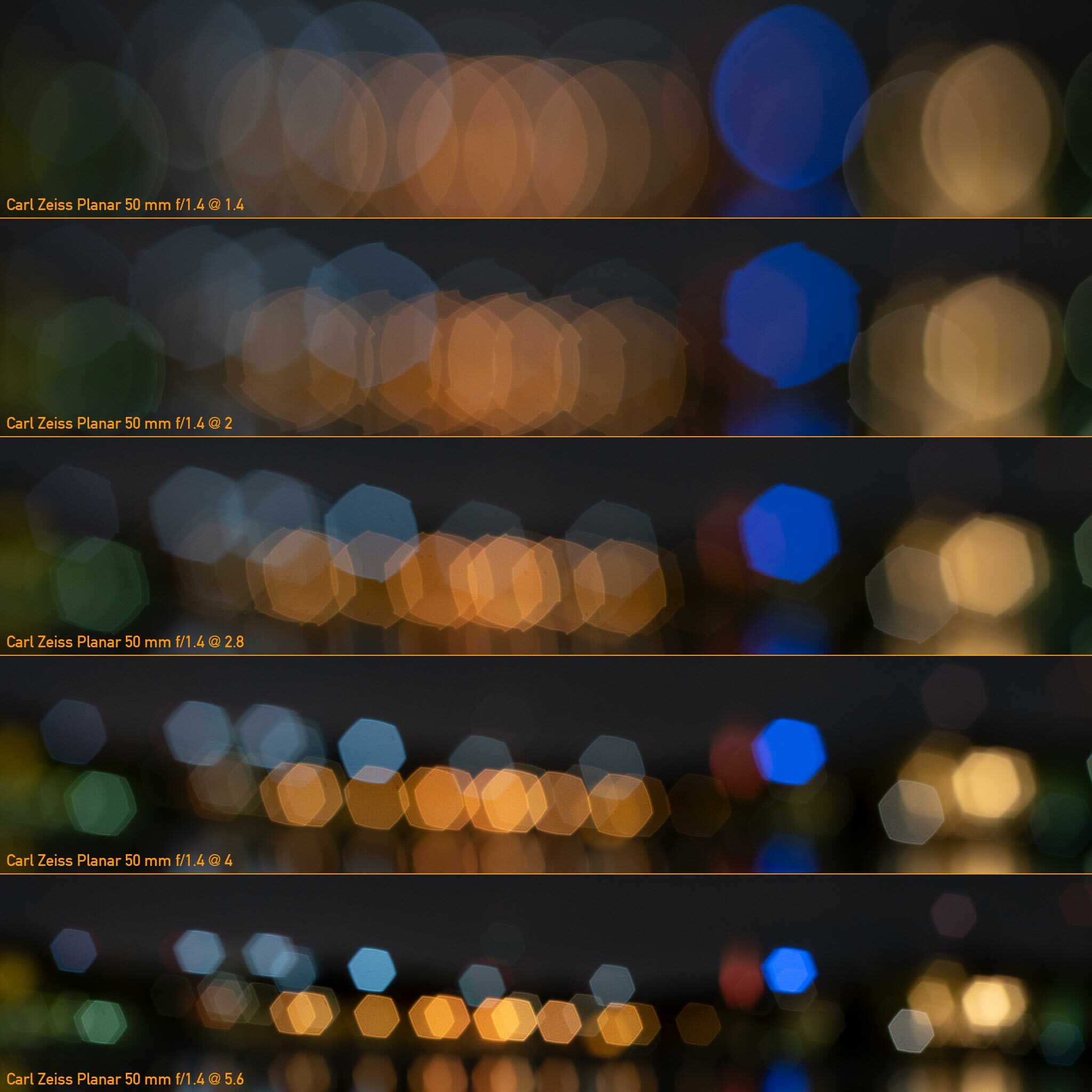
Quick analysis:
f/1.4 Circular, well corrected bokeh balls, but with noticeable optical vignetting in border areas.
f/2 Corrected with very mild outlining. Distinct saw blade pattern. Mild optical vignetting in extreme border areas.
f/2.8 Hexagon with remnants of saw blade teeth. Mild, but noticeable onion-ring outlining
f/4–f/5.6 Slightly rounded hexagon. No optical vignetting but distinct onion-ring outlining.
Konica Hexanon AR 50 mm f/1.4
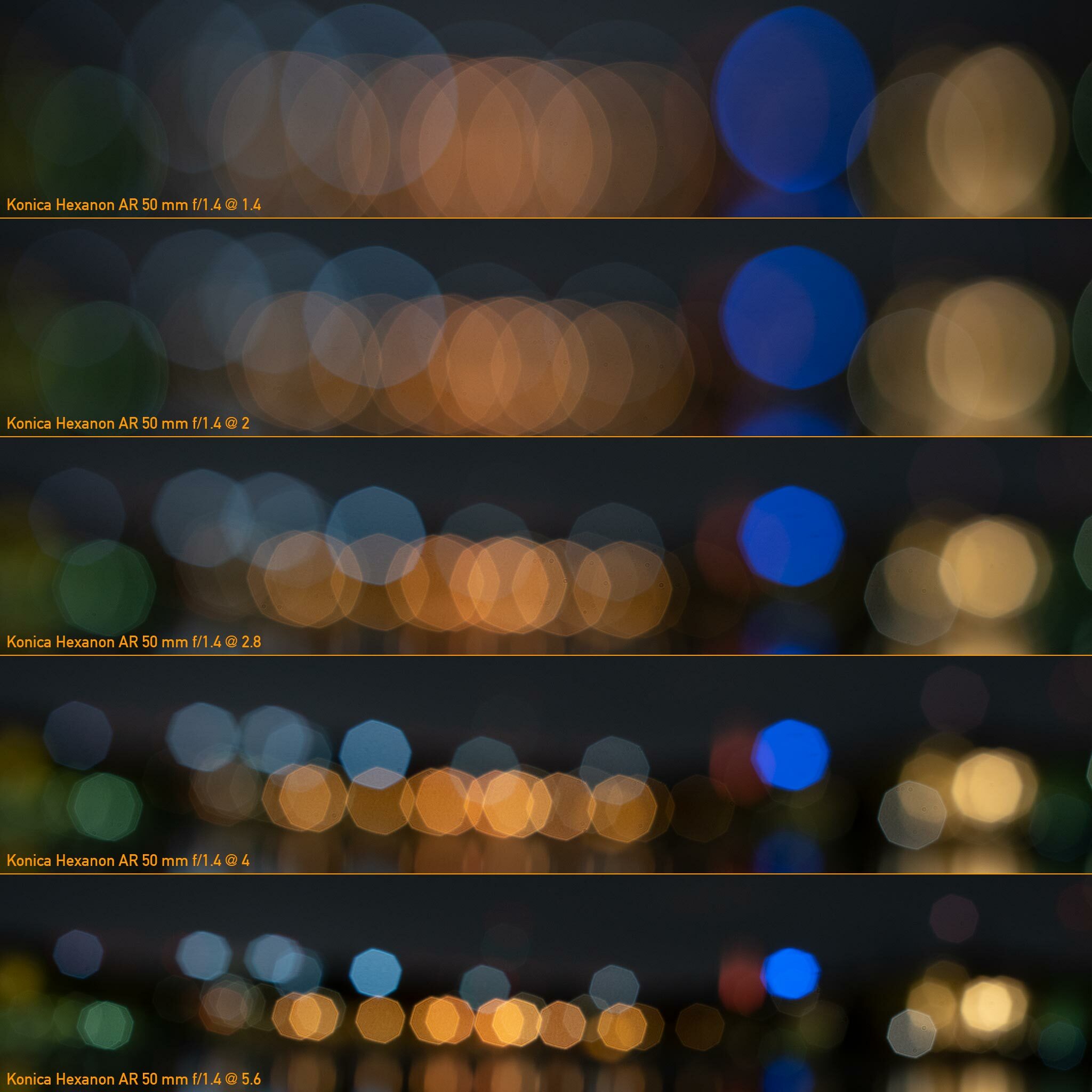
Quick analysis:
f/1.4 Circular, slightly overcorrected bokeh balls with noticeable optical vignetting in border areas.
f/2 Corrected with very mild outlining. Shape shows the eight blades, but is quite round. Mild optical vignetting in extreme border areas.
f/2.8 Rounded octagon. Mild outlining. No optical vignetting
f/4–f/5.6 Clear octagonal shape. Otherwise well-corrected but distinct onion-ring outlining.
Minolta Auto Rokkor-PF 58 mm f/1.4
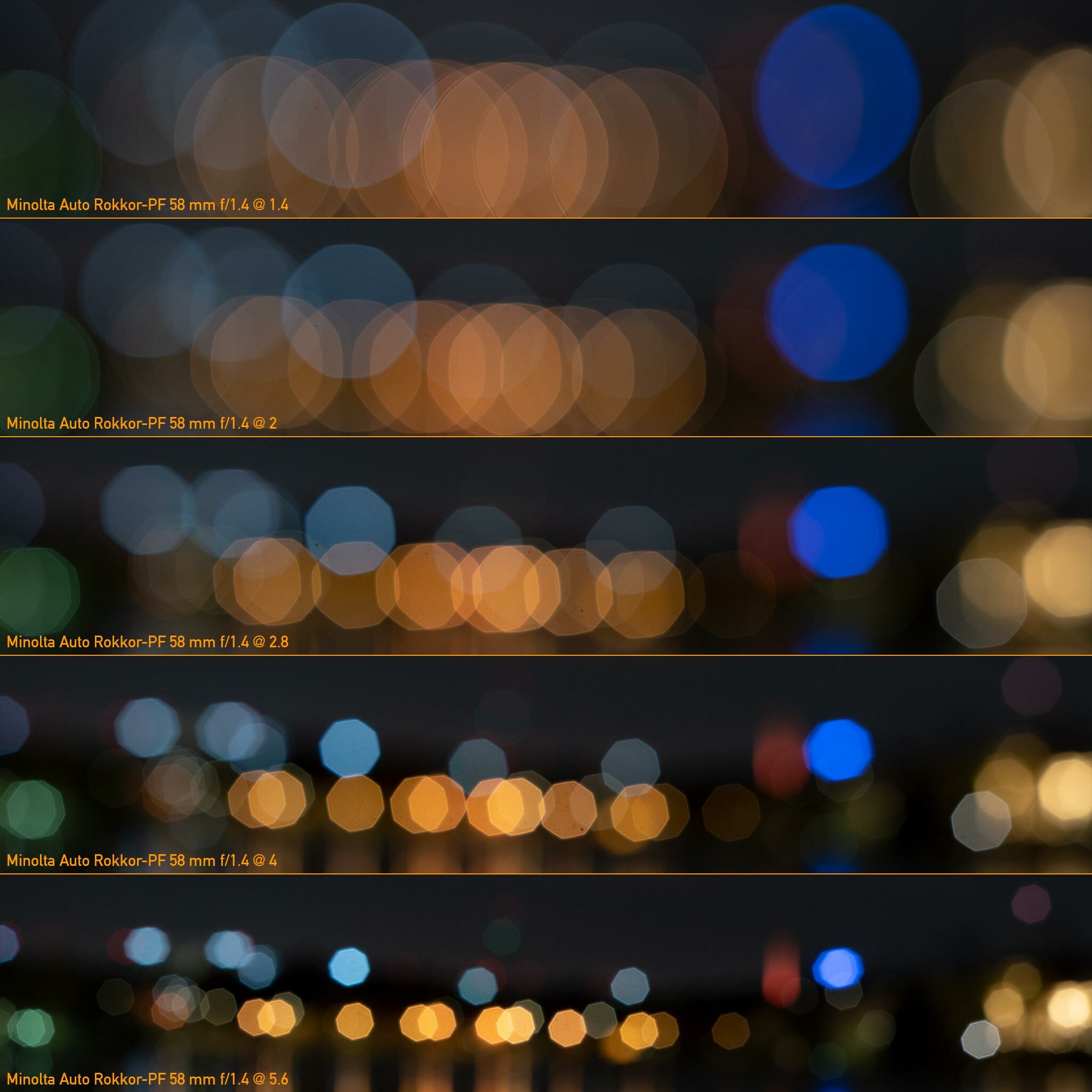
Quick analysis:
f/1.4 Circular, slightly overcorrected bokeh balls with some optical vignetting in border areas.
f/2 Corrected with very mild outlining. Shape shows the eight blades, but is quite round. Insignificant optical vignetting
f/2.8 Octagon with rounded corners. Mild outlining. No optical vignetting
f/4–f/5.6 Distinct octagonal shape. Otherwise well-corrected but distinct onion-ring outlining.
Minolta MC Rokkor-PG 50 mm f/1.4
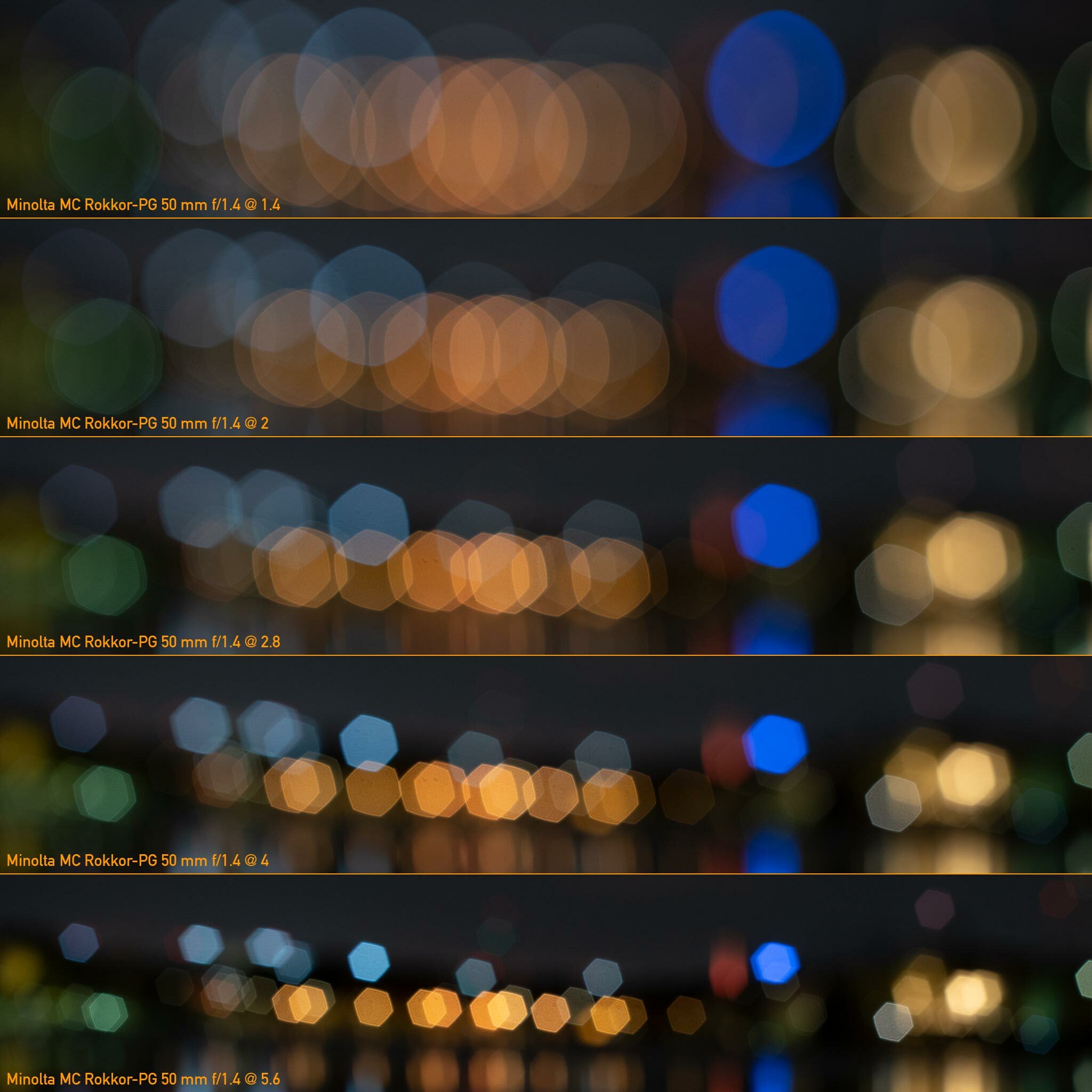
Quick analysis:
f/1.4 Circular, well-corrected bokeh balls with some optical vignetting in border areas.
f/2 Well-rounded hexagon. Corrected with very mild outlining. Insignificant optical vignetting
f/2.8 Hexagon with rounded corners. Some outlining. No optical vignetting
f/4–f/5.6 Distinct hexagonal shape. Otherwise well-corrected but distinct onion-ring outlining.
Pentax-M (SMC) 50 mm f/1.4
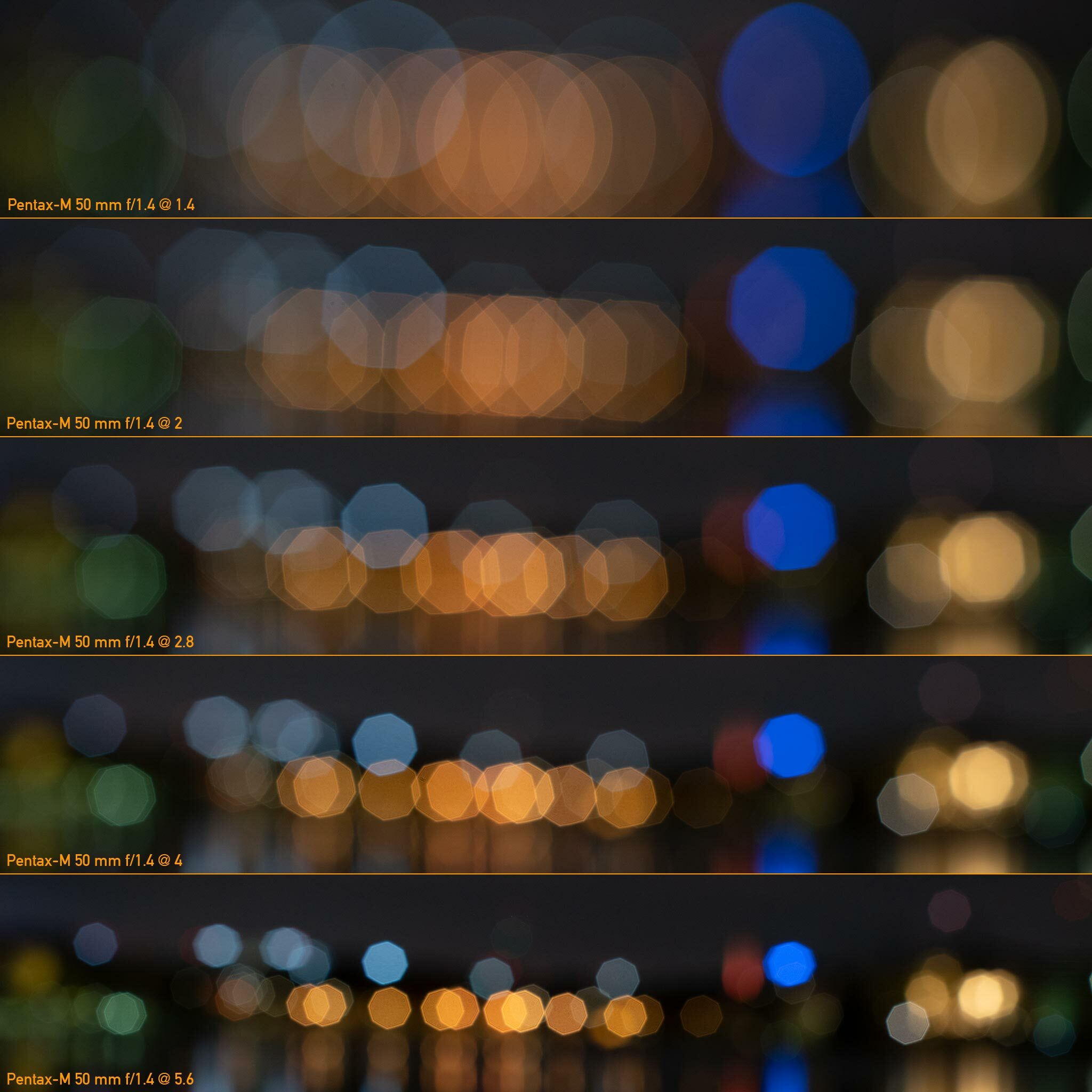
Quick analysis:
f/1.4 Circular bokeh balls with minor outlining and some optical vignetting in border areas.
f/2 Distinct octagon with jagged (toothlike) corners. Corrected with minor outlining. Insignificant optical vignetting
f/2.8-f/4 Octagonal shape, very mildly rounded. Some outlining. No optical vignetting
f/5.6 Octagonal shape. Otherwise well-corrected but very clear onion-ring outlining.
Revuenon (Auto) MC 50 mm f/1.4
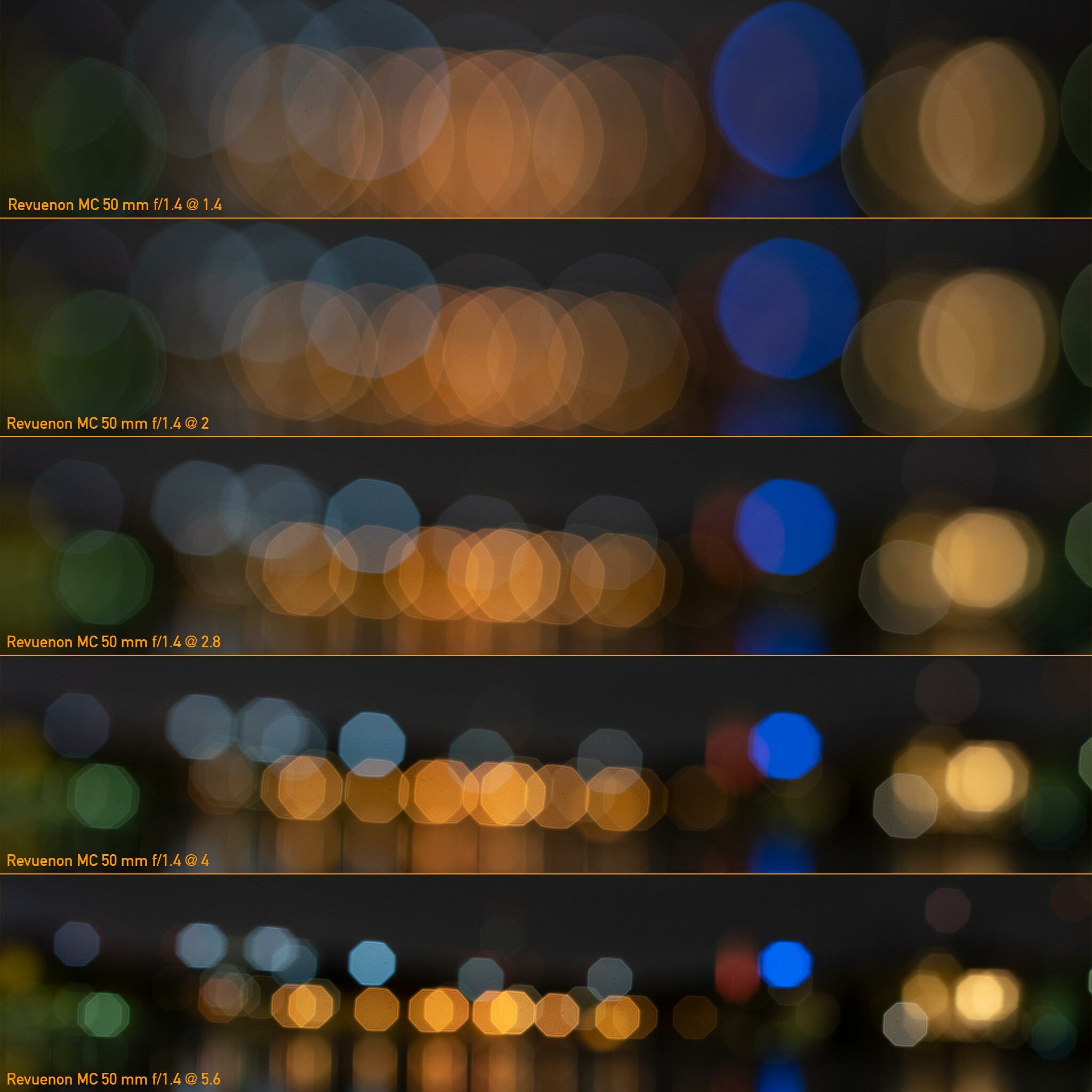
Quick analysis:
f/1.4 Circular bokeh balls with minor outlining and some optical vignetting in border areas.
f/2 Distinct octagon with jagged (toothlike) corners (similar to but less distinct than the Pentax). Corrected with minor outlining. Insignificant optical vignetting
f/2.8 Octagonal shape, very mildly rounded. Some outlining. No optical vignetting
f/4–f/5.6 Octagonal shape. Otherwise well-corrected but very clear onion-ring outlining.
Some comments:
While the AE Carl Zeiss Contax/Yashica lenses are notorious for their circular-saw-blade or ‘ninja star’ apertures, this comparison shows that compared to its eastern brethren, the Zeiss Planar’s aperture shape is almost lame. I hereby declare the 50 mm f/1.4 Prakticar to be the Official Ninja Star Lens. On the other hand, given the Prakticar’s rather good performance regarding overall bokeh, this might not be only a drawback.
Moreover, while the ‘ninja star’-like aperture shape is a fleeting occurrence on the Zeiss Planar (gone by f/4), not so with the Prakticar.
I also find it significant that both the Pentax as well as (albeit to a lesser degree) the Revuenon show jagged, toothlike aperture corner artefacts at f/2. Granted, the effect is far from as significant as with the Zeiss, but nevertheless clearly noticeable:
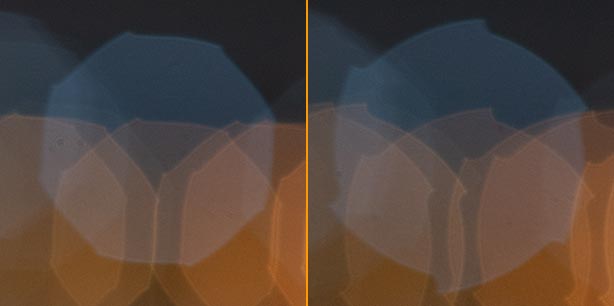
Right: Carl Zeiss @f/2
Otherwise on must conclude that the comparison does not highlight any other extreme differences. All lenses in this comparison have either 6 or 8 aperture blades. Most of the lenses’ blade rounding is such that it ranges to keep the aperture almost circular at f/2 (all except the East and West Zeisses, the Pentax and Revuenon).
Stargazing
Well … Believe it or not, I am unable to offer you a really good set of starscapes for your perusal. The reason is quite simple: I live in an area with:
• considerable light pollution, which means that if I want to take starscapes I have to plan a trip for that…
• in the summer it does not really get dark …
• when it gets sufficiently dark, it is typically either very cloudy or
• bitingly cold and taking a set of test shots with 9 lenses, at various apertures, and with low ISO takes enough time that you don’t really want the temperature to be significantly below -10°…
Even so, I did set out to take one such set of shots, but managed to bungle the Hexanon’s focusing (and did not notice it until it was too late to do anything about it. As the 58 mm Minolta furthermore being unable to focus at stars, I can only offer you starscapes on 7 of the 9 lenses in the comparison. We’ll go through these lenses one by one:
All Images: Sony ⍺7R2, ISO 3200, WB 3500°, Tripod and cable release. Manual mode. ACR default, only resized.
Each image shows a scaled-down version of the entire 42 megapixel image (533×800 in preview, 1366×2048 in larger version) as well as a top-left corner excerpt (scaled down in preview, 1:1 in larger version).
Note: I know these star shots are not impressive examples of astrophotography, but if you look into the typical process for astrophotography, you’ll understand why that process is not really suitable to producing test shots.
Canon FD 50 mm f/1.4 ‘chrome nose’
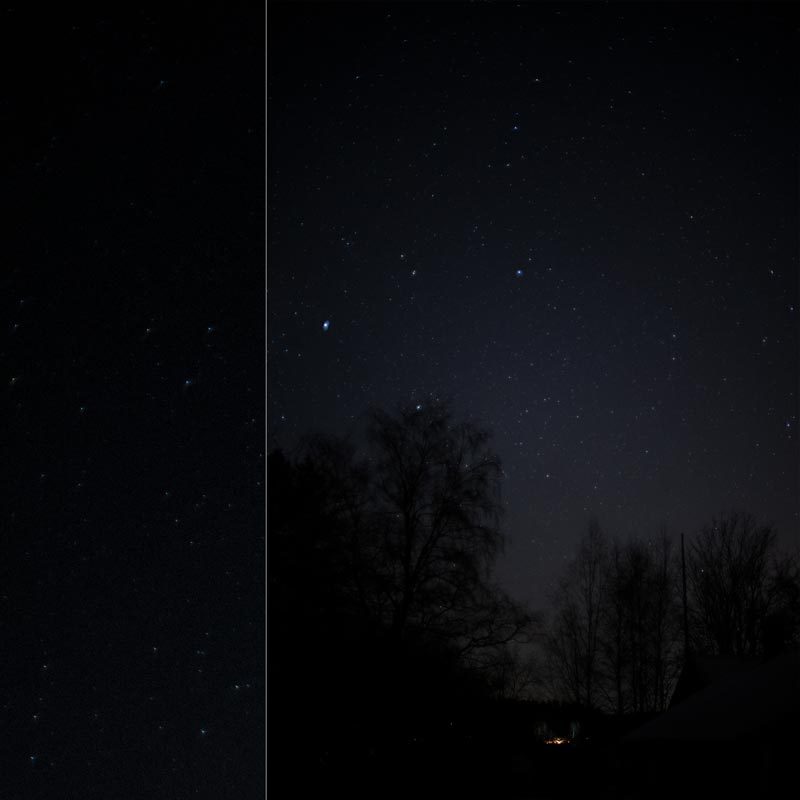
(click here for larger version)
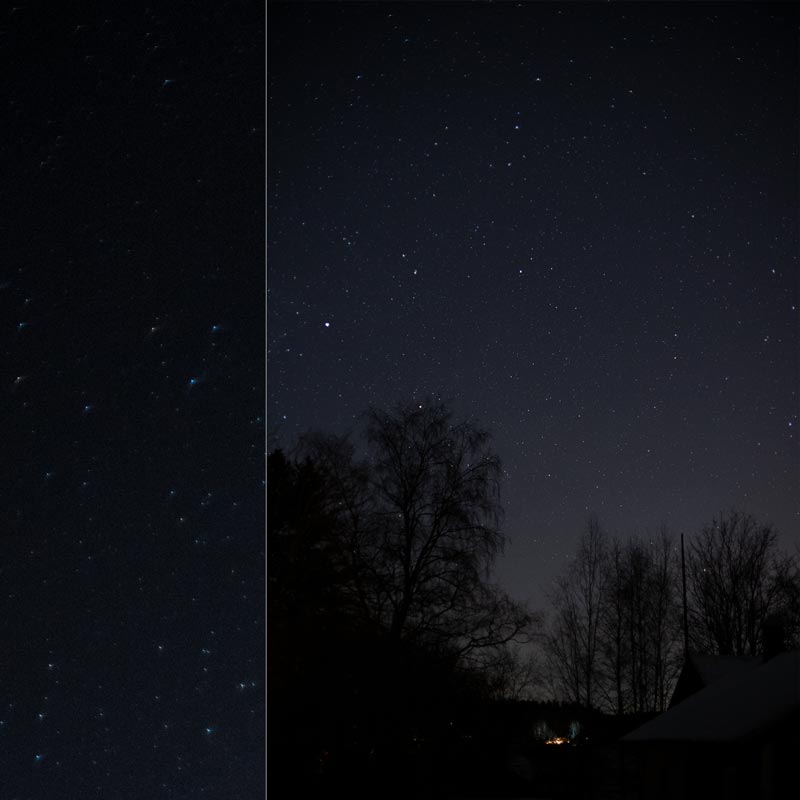
(click here for larger version)

(click here for larger version)

(click here for larger version)
Quick analysis:
Astigmatism (not coma) is an issue in the absolute corners from f/1.4 to f/2.8, but at f/4 the image is overall nice. Wide open there is some flare veiling around the brightest light-points.
Canon FDn 50 mm f/1.4
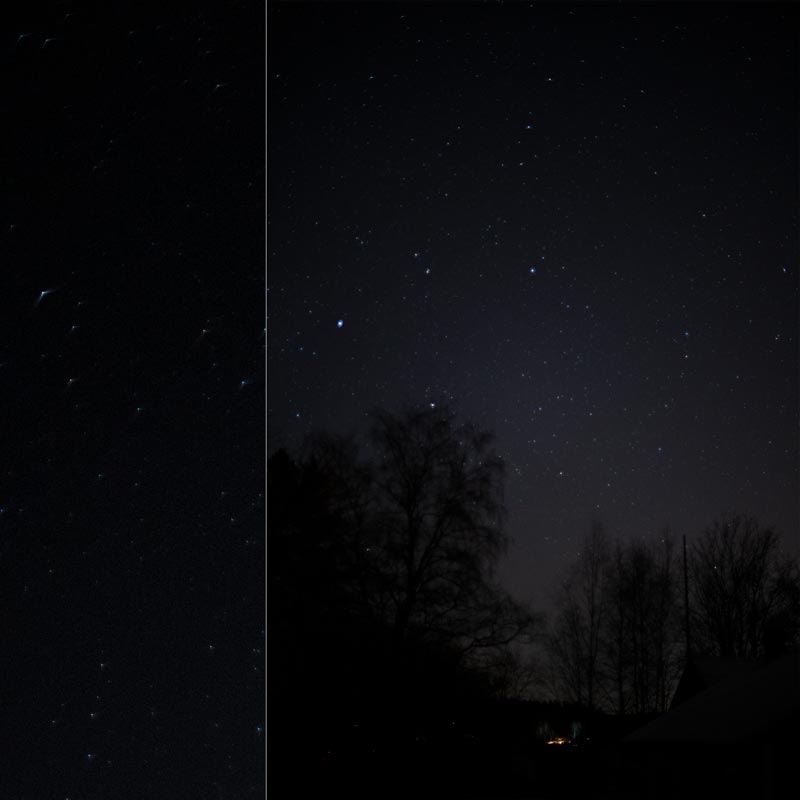
(click here for larger version)
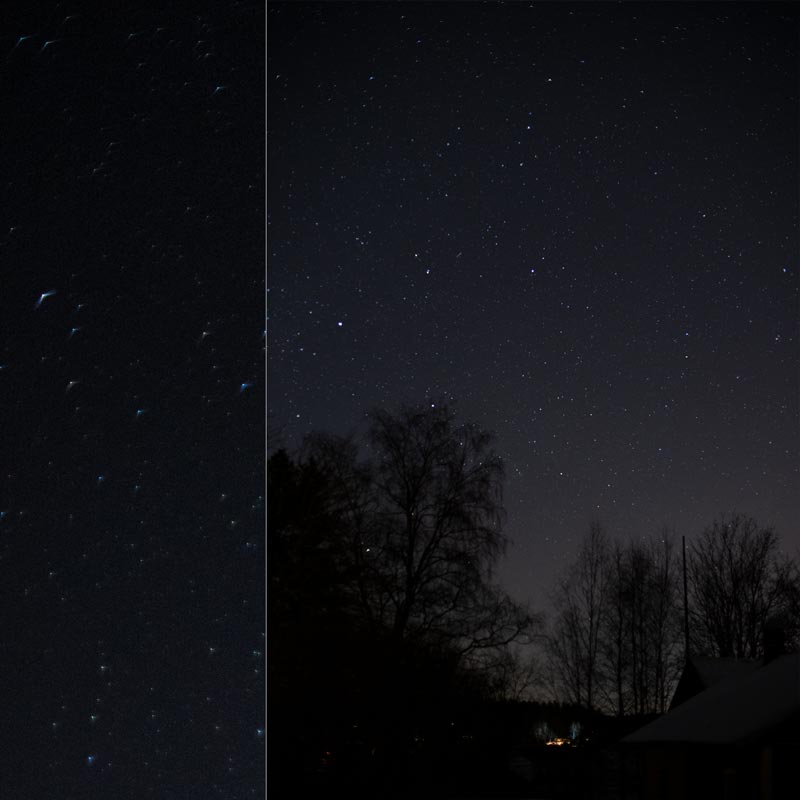
(click here for larger version)
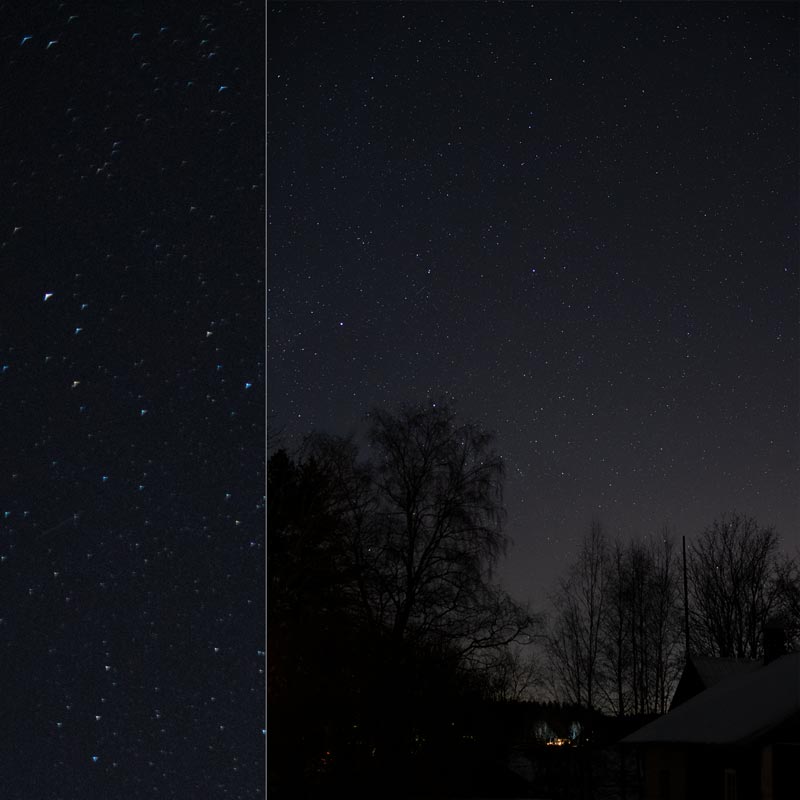
(click here for larger version)
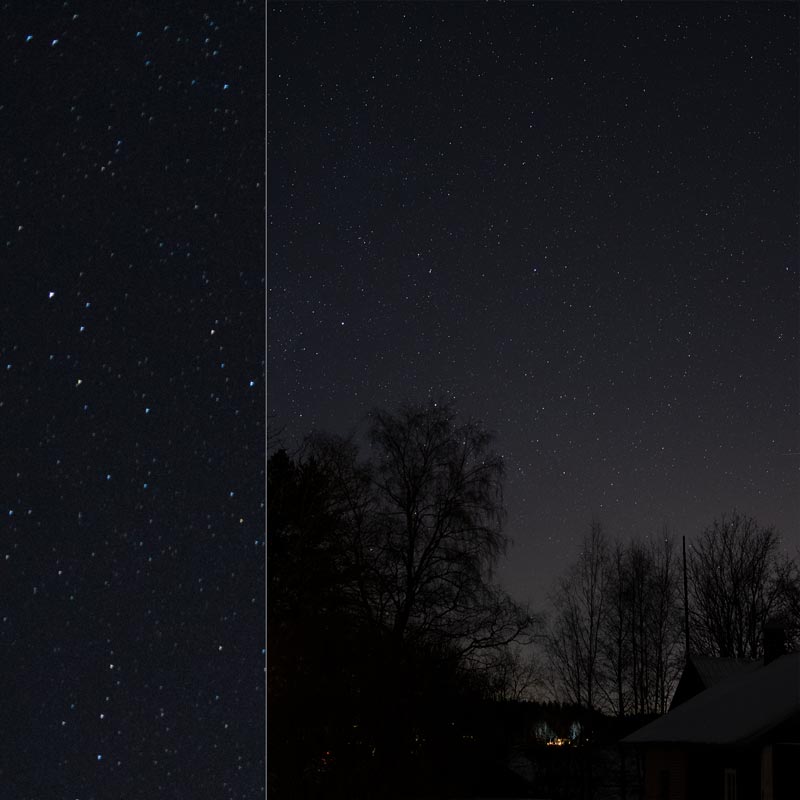
(click here for larger version)
Quick analysis:
Astigmatism (not coma) is an issue in the absolute corners from f/1.4 to f/2.8, which is a problem if a significant enlargement is desired. Wide open there is some flare veiling around the brightest light-points.
Carl Zeiss Jena Prakticar 50 mm f/1.4
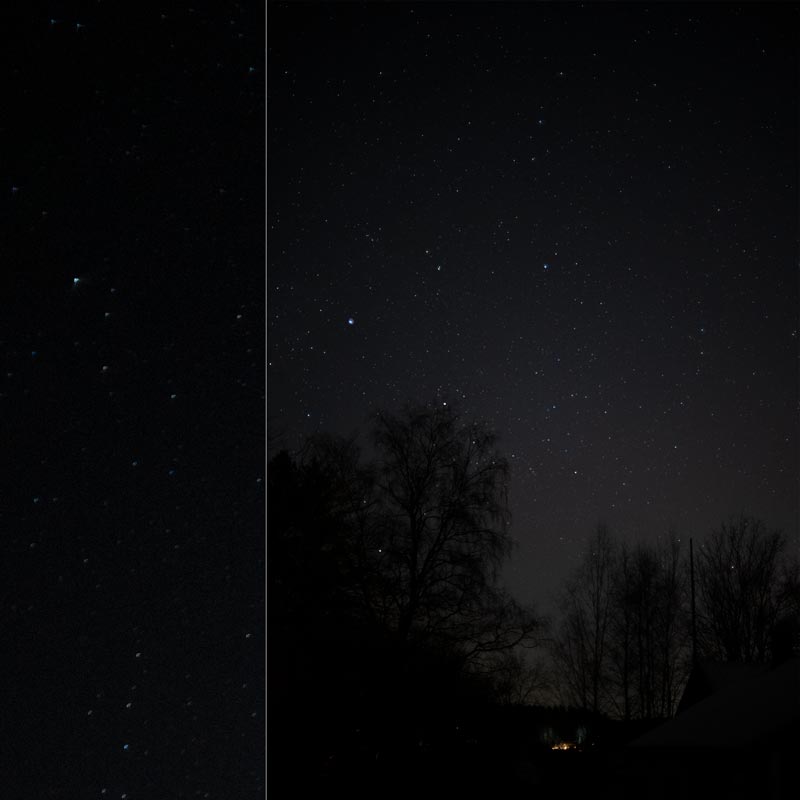
(click here for larger version)
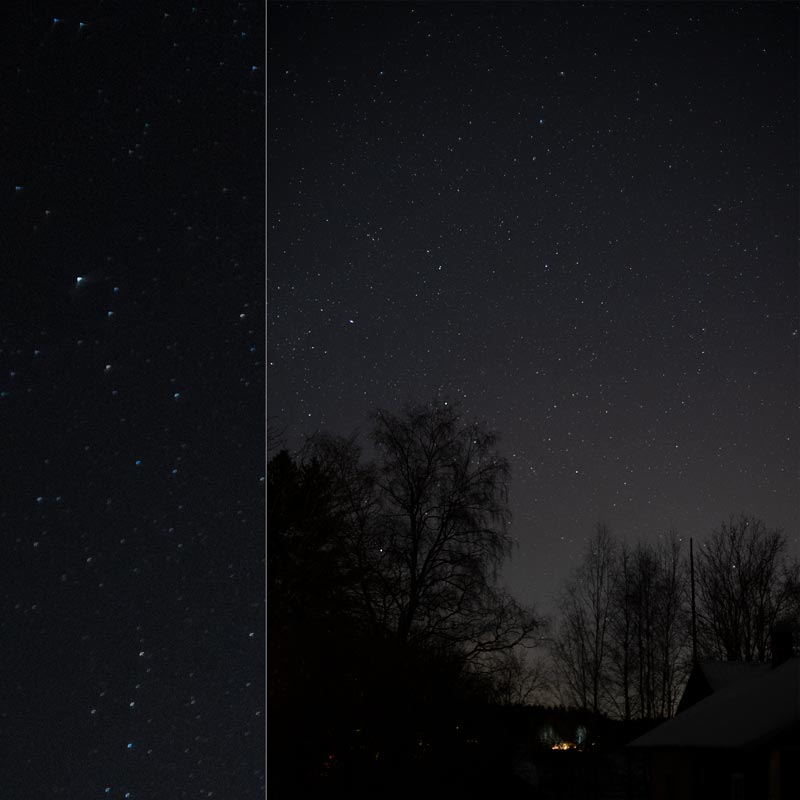
(click here for larger version)
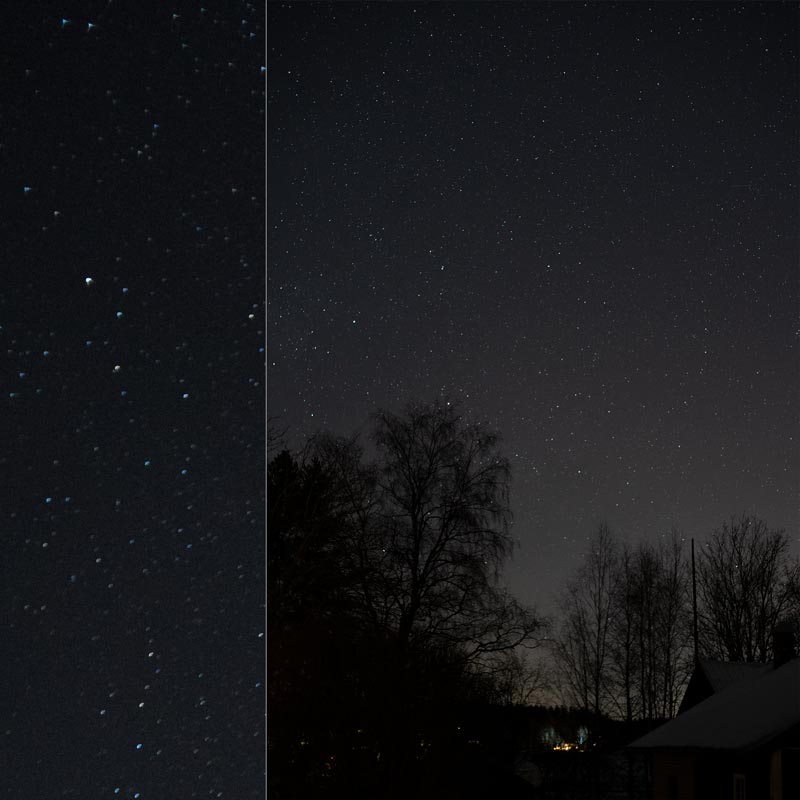
(click here for larger version)
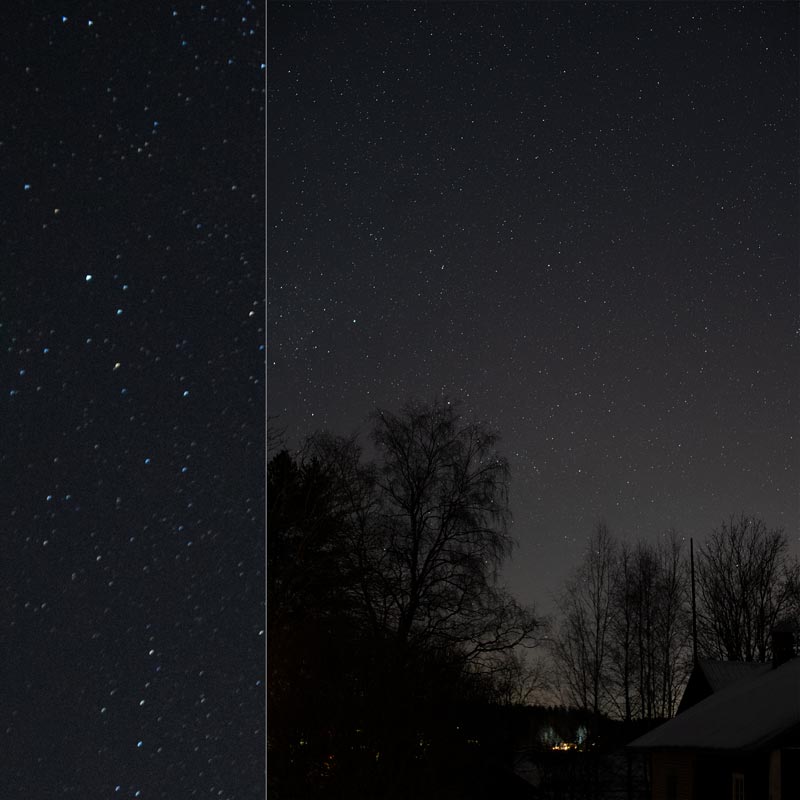
(click here for larger version)
Quick analysis:
The Carl Zeiss Jena Prakticar has both astigmatism as well as sagittal smearing (likely a combination of astigmatism and field curvature) is an issue in the absolute corners from f/1.4 to f/4, which is a problem if a significant enlargement is desired. Wide open there is some flare veiling around the brightest light-points.
Carl Zeiss Planar 50 mm f/1.4
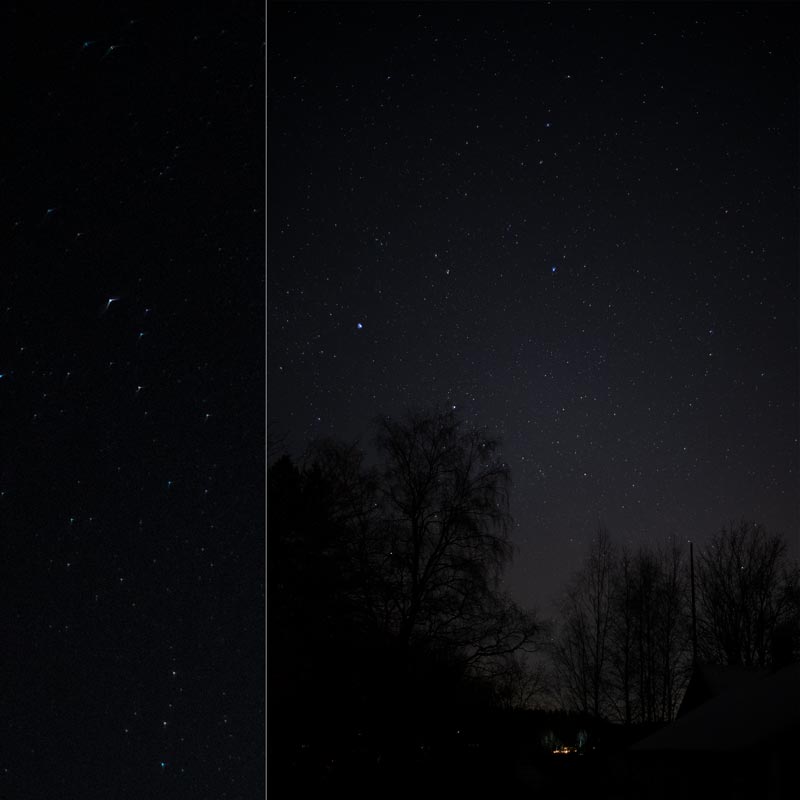
(click here for larger version)
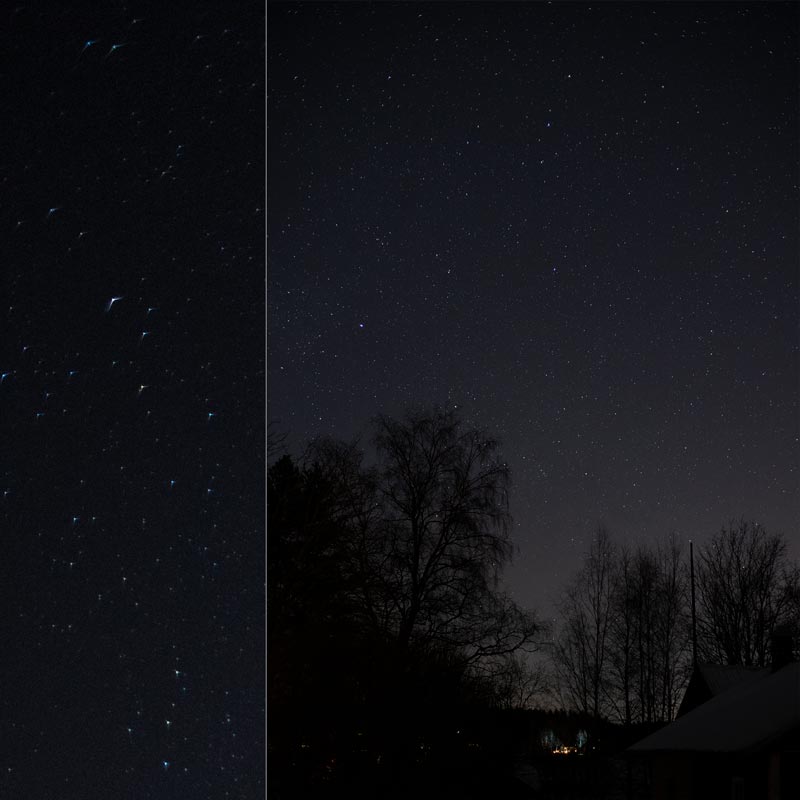
(click here for larger version)
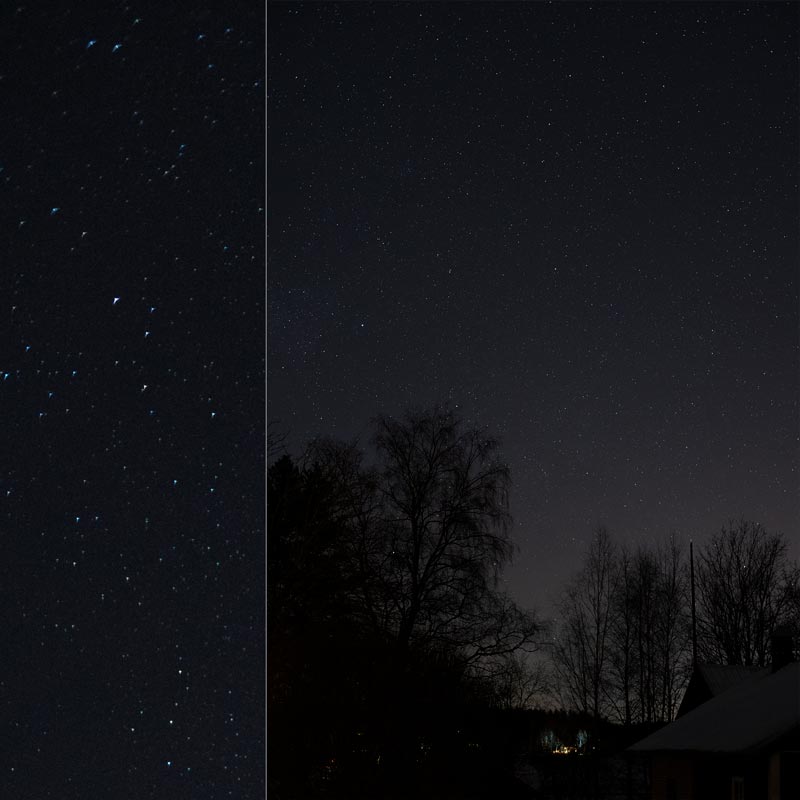
(click here for larger version)
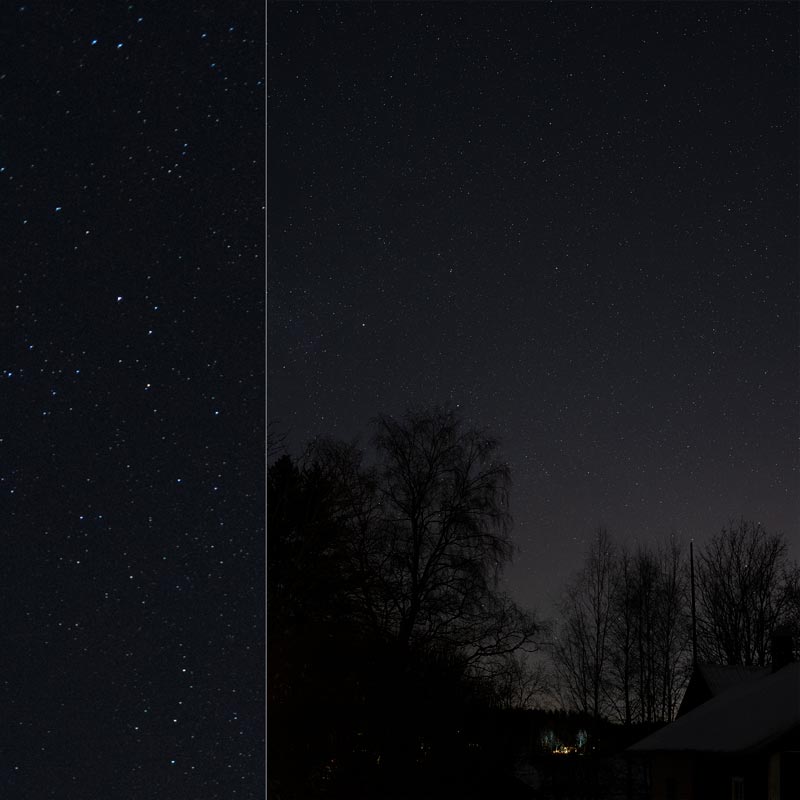
(click here for larger version)
Quick analysis:
The Carl Zeiss Planar has some astigmatism that becomes manageable by f/4, but does not entirely go away even there. Wide open there is minor flare veiling around the brightest light-points.
Minolta MC 50 mm f/1.4
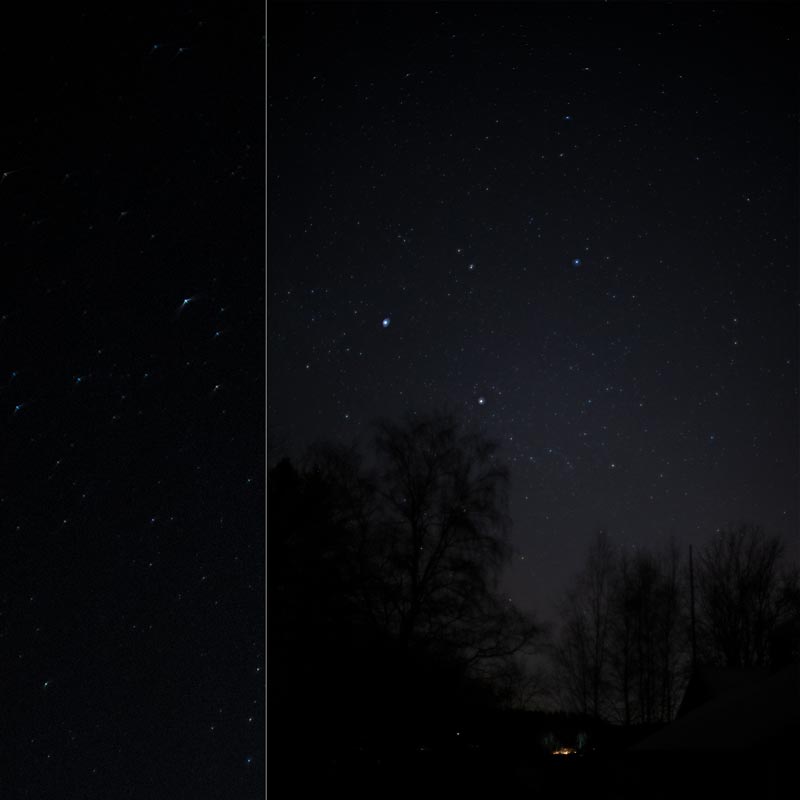
(click here for larger version)

(click here for larger version)
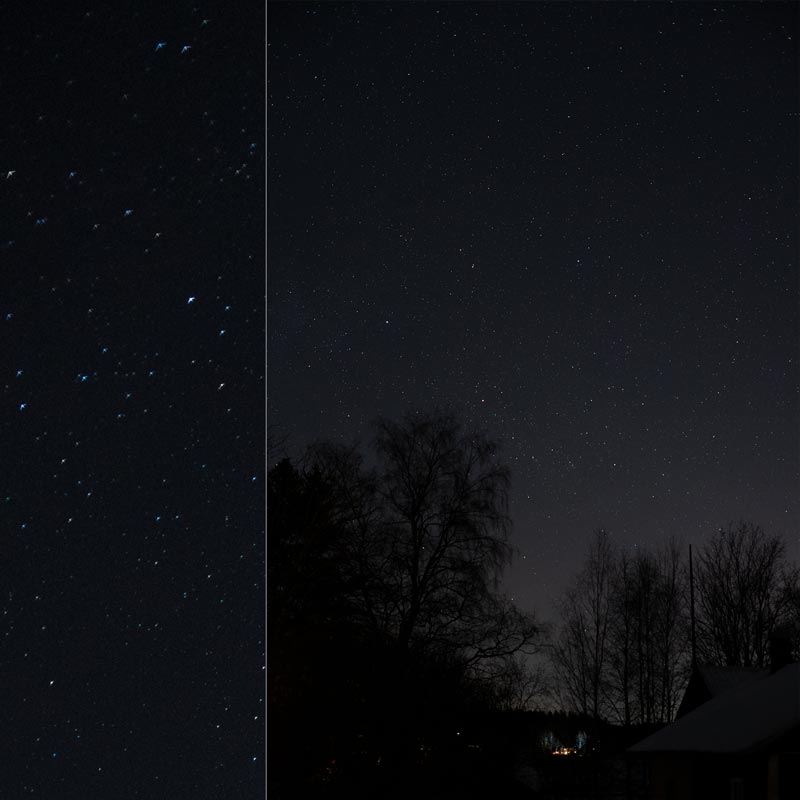
(click here for larger version)
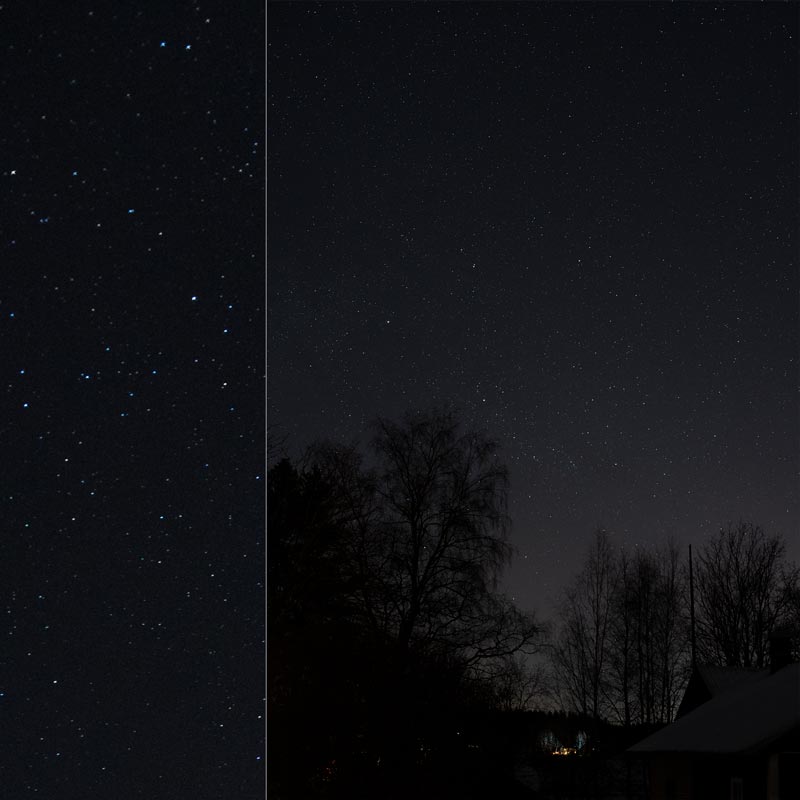
(click here for larger version)
Quick analysis:
While the 50 mm Minolta performs really well at f/4, at wider apertures the lens suffers badly from both flare veiling and astigmatism.
Pentax-M 50 mm f/1.4
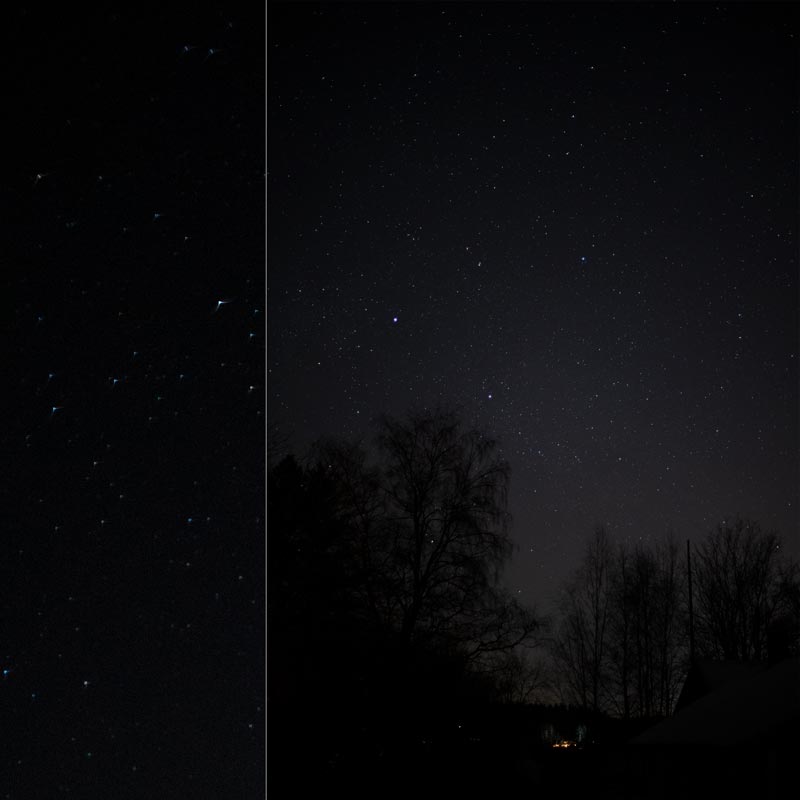
(click here for larger version)

(click here for larger version)
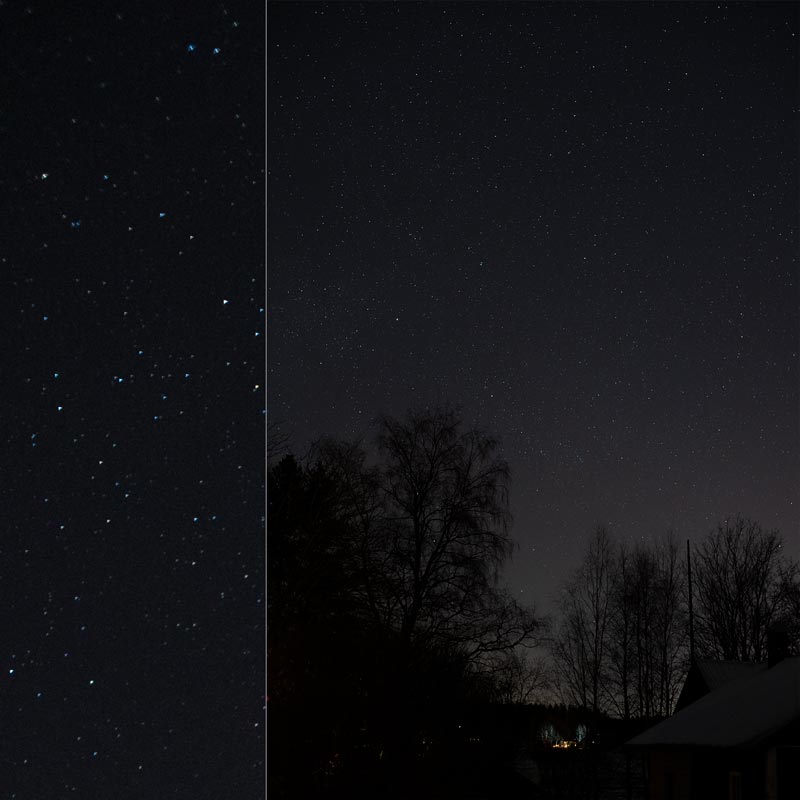
(click here for larger version)
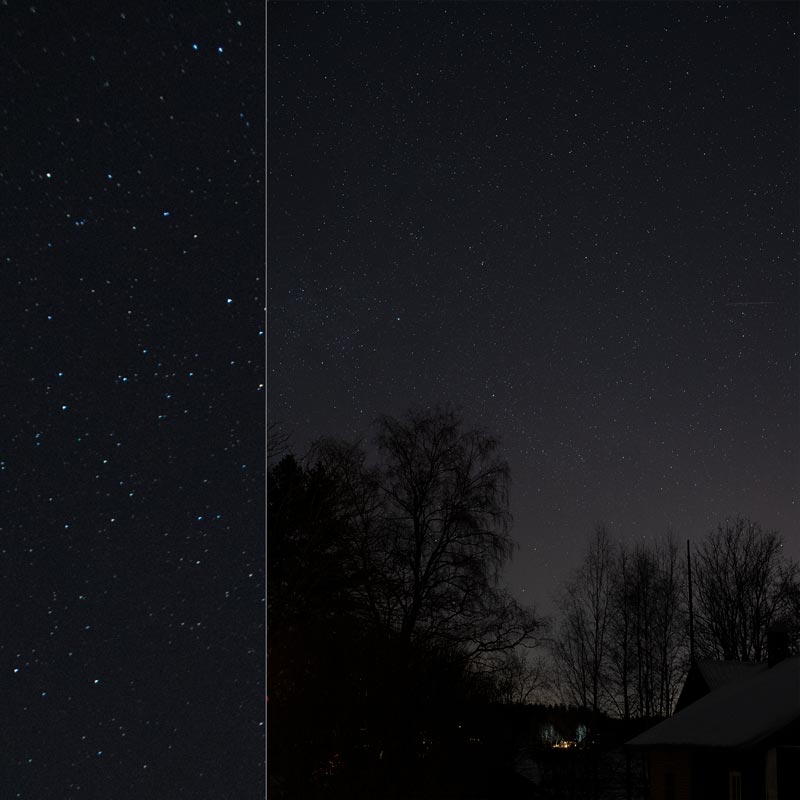
(click here for larger version)
Quick analysis:
The 50 mm Pentax performs quite well at f/2.8 and f/4, and the existing astigmatism can only be discerned at 1:1 magnification. Simultaneously, the Pentax does not produce the best of contrasts. At wider apertures the lens has some astigmatism and relatively minor veiling at wide open.
Revuenon MC 50 mm f/1.4
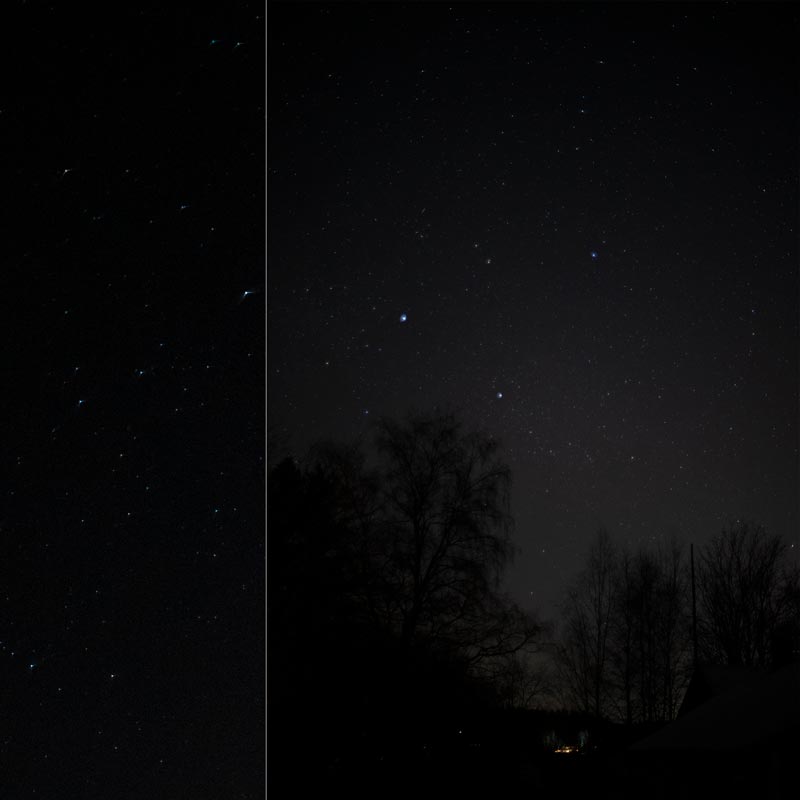
(click here for larger version)
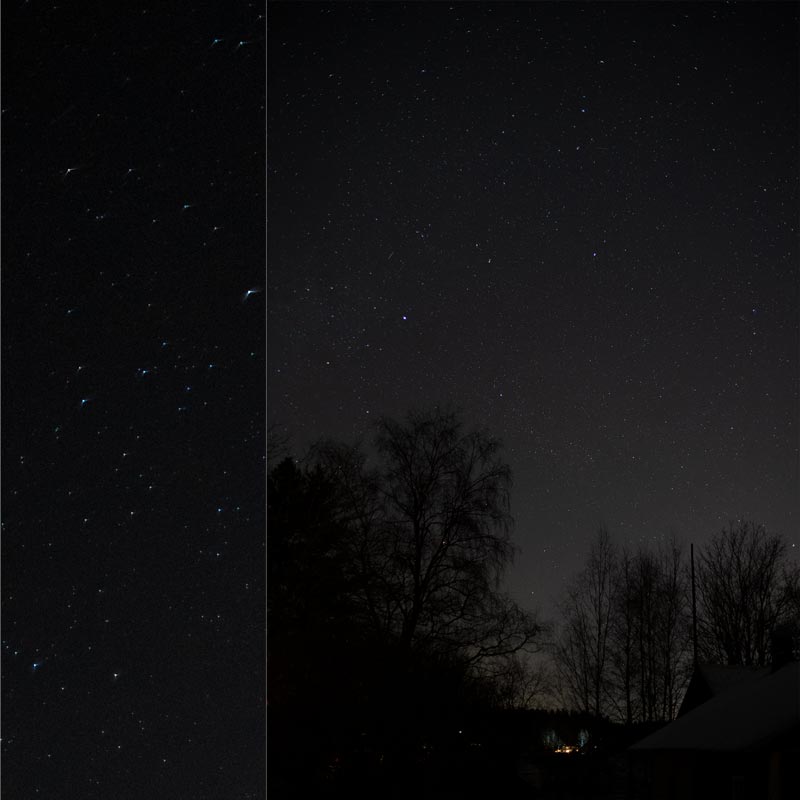
(click here for larger version)
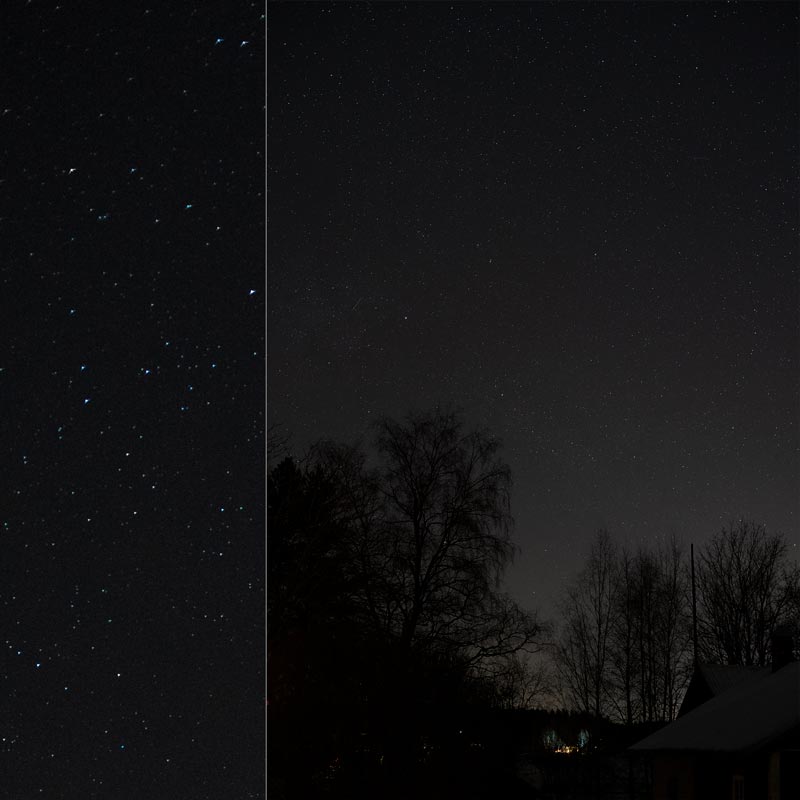
(click here for larger version)

(click here for larger version)
Quick analysis:
The Revuenon shows some flare veiling wide open, and shows some astigmatism at f/1.4 and f/2. from f/2.8 onward the result is as good as can be hoped for with a legacy lens.
Interpretation of starscapes:
These images do show that while none of these lenses manage to perform as well as a modern, computer-designed lens, neither are they all as bad. On the contrary, there are lenses that perform remarkably well (Revuenon), lenses that perform surprisingly badly (Canon FDn) and lenses that perform unsurprisingly badly (Carl Zeiss Jena) at this task. That said, it is a shame i bungled the Hexanon’s imagery, as it would have been interesting to see how it performed.
While all of these lenses are able to produce a decent star-scape photograph, there is no way to recommend any of these for a photographer intent on producing clean, crisp, high-resolution astro-photos.
One more thing:
Finally, given that these images were shot in manual mode, and as all have the same white balance, this set of images allows a rare glimpse into transmission and color. The following images are composites that each show a centre-to-border crop at f/1.4:
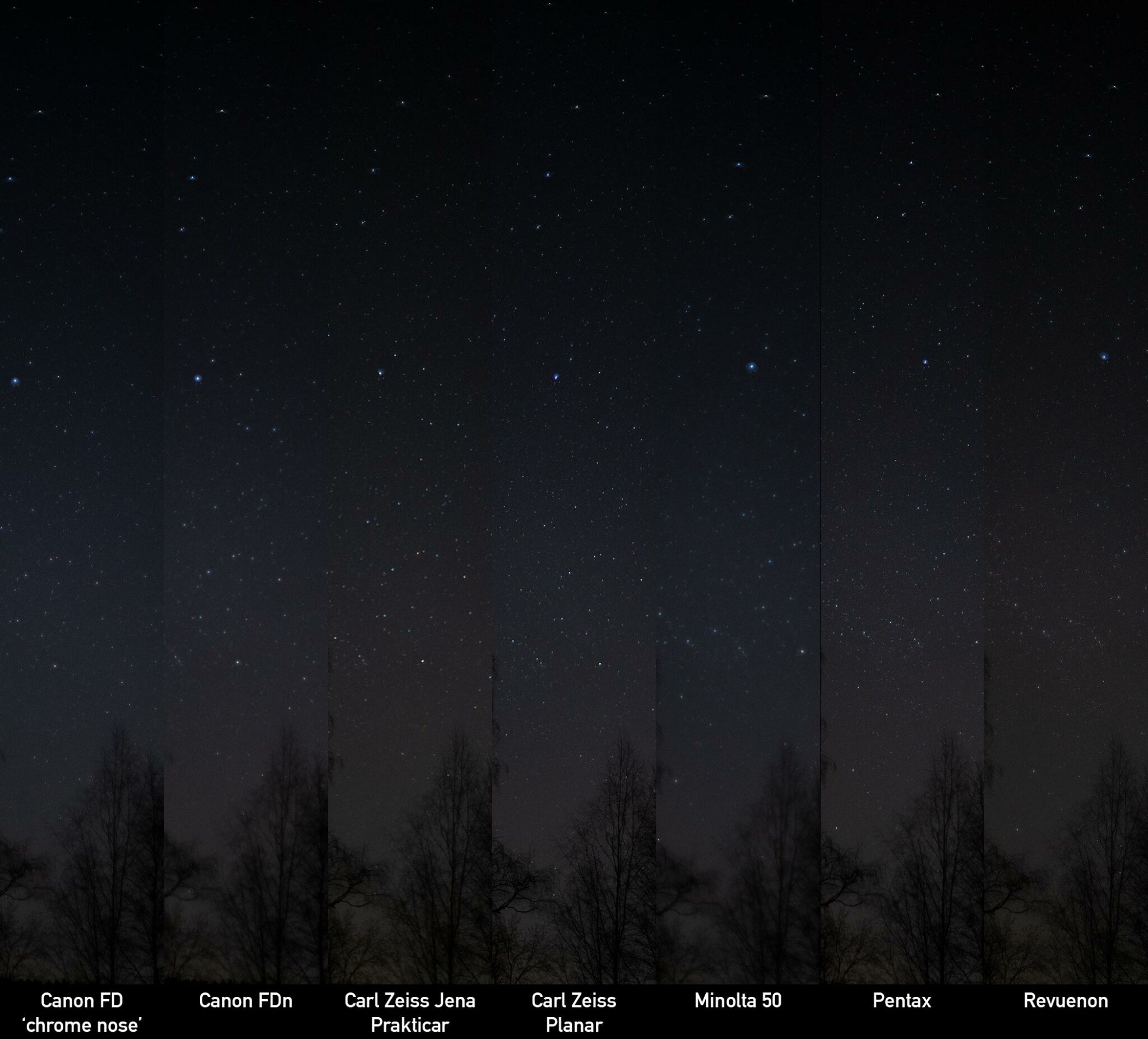
And in this situation, that the differences in transmission and especially tonality are quite plain to see.
Next…?
• Part 1: Introduction, the lenses: pedigree and handling
• Part 2: IQ-comparison I – The Brick wall test
• Part 3: IQ comparison II – Urban vistas
• Part 4: IQ-comparison III – Bokeh and blur
• Part 5: IQ-comparison IV – Night-time vistas (you are here)
• Part 6: Summary and conclusions